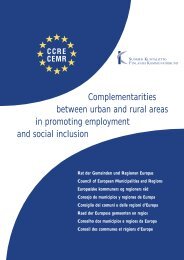The impact of demographic change on local and regional government
The impact of demographic change on local and regional government
The impact of demographic change on local and regional government
You also want an ePaper? Increase the reach of your titles
YUMPU automatically turns print PDFs into web optimized ePapers that Google loves.
This publicati<strong>on</strong> was written by Dr Beate Hollbach-Grömig <strong>and</strong> Dipl.-Soz. Jan Trapp <str<strong>on</strong>g>of</str<strong>on</strong>g> the German Institute<str<strong>on</strong>g>of</str<strong>on</strong>g> Urban Affairs, for the Council <str<strong>on</strong>g>of</str<strong>on</strong>g> EuropeanMunicipalities <strong>and</strong> Regi<strong>on</strong>s (CEMR).German Institute <str<strong>on</strong>g>of</str<strong>on</strong>g> Urban Affairs /Deutsches Institut fürUrbanistik (DIFU)Straße des 17. Juni 112D-10623 BerlinGermanyThis publicati<strong>on</strong> can be downloaded from CEMRwebsite: www.ccre.orgBrussels, May 2006
[ ]<str<strong>on</strong>g>The</str<strong>on</strong>g> Impact <str<strong>on</strong>g>of</str<strong>on</strong>g> Demographic Change <strong>on</strong> Local <strong>and</strong> Regi<strong>on</strong>al Government- Research ProjectC<strong>on</strong>tents1. Introducti<strong>on</strong> - Background to the Study <strong>and</strong> some Methodological Remarks2.2. Demographic Changes in Europe2.1 Trends2.2 C<strong>on</strong>sequences for the Regi<strong>on</strong>al <strong>and</strong> Local Levels2.3 Demographic Situati<strong>on</strong> in the Czech Republic, Finl<strong>and</strong>, Germany <strong>and</strong> Spain• Czech Republic• Finl<strong>and</strong>• Germany• Spain3.34456783. Demographic Change in Four Policy fields: Social Services, Spatial Planning,3. Employment/Social Inclusi<strong>on</strong> <strong>and</strong> Local Community Activities3.1 Social Services• Relati<strong>on</strong>ship between social services <strong>and</strong> demography• Activities <strong>and</strong> reacti<strong>on</strong> strategies: examples from the 4 countries3.2 Spatial Planning• Relati<strong>on</strong>ship between Spatial Planning <strong>and</strong> Demography• Activities <strong>and</strong> reacti<strong>on</strong> strategies: Examples from the 4 countries3.3 Employment <strong>and</strong> Social Inclusi<strong>on</strong>• Relati<strong>on</strong>ship between Employment/Social Inclusi<strong>on</strong> <strong>and</strong> Demography• Activities <strong>and</strong> reacti<strong>on</strong> strategies: examples from the 4 countries3.4 Local Community Activities• Relati<strong>on</strong>ship between <strong>local</strong> community activities <strong>and</strong> demography• Activities <strong>and</strong> reacti<strong>on</strong> strategies: examples from the 4 countries999101212131414151616174. Summary <strong>and</strong> C<strong>on</strong>clusi<strong>on</strong>185. Further Inquiry <strong>and</strong> Research Questi<strong>on</strong>s19<str<strong>on</strong>g>The</str<strong>on</strong>g> Council <str<strong>on</strong>g>of</str<strong>on</strong>g> European Municipalities <strong>and</strong> Regi<strong>on</strong>s in a nutshell201
1Background to the Study<strong>and</strong> some Methodological RemarksIntroducti<strong>on</strong>All European countries are facing challenges from<str<strong>on</strong>g>demographic</str<strong>on</strong>g> <str<strong>on</strong>g>change</str<strong>on</strong>g>. <str<strong>on</strong>g>The</str<strong>on</strong>g>se fundamental, seriousdevelopments have complex c<strong>on</strong>sequences for <strong>local</strong> <strong>and</strong>regi<strong>on</strong>al authorities. <str<strong>on</strong>g>The</str<strong>on</strong>g> <str<strong>on</strong>g>impact</str<strong>on</strong>g> <str<strong>on</strong>g>of</str<strong>on</strong>g> <str<strong>on</strong>g>demographic</str<strong>on</strong>g> <str<strong>on</strong>g>change</str<strong>on</strong>g>swill differ from city to city <strong>and</strong> from regi<strong>on</strong> to regi<strong>on</strong>. Butthey influence nearly every sphere <str<strong>on</strong>g>of</str<strong>on</strong>g> life: labour markets,housing markets, social security systems, infrastructure,urban/spatial planning, educati<strong>on</strong>, budgets <strong>and</strong> finances.Experience with the <str<strong>on</strong>g>impact</str<strong>on</strong>g> <str<strong>on</strong>g>of</str<strong>on</strong>g> <str<strong>on</strong>g>demographic</str<strong>on</strong>g> <str<strong>on</strong>g>change</str<strong>on</strong>g> hasengendered strategies to face these developments in anumber <str<strong>on</strong>g>of</str<strong>on</strong>g> countries <strong>and</strong> municipalities.<str<strong>on</strong>g>The</str<strong>on</strong>g> study examines <strong>local</strong> authorities <str<strong>on</strong>g>of</str<strong>on</strong>g> different sizes infour countries, namely the Czech Republic, Finl<strong>and</strong>,Germany <strong>and</strong> Spain. It gives a first impressi<strong>on</strong> bydocumenting <strong>and</strong> synthesising the challenges facingmunicipalities in different European countries, in differentspatial c<strong>on</strong>texts <strong>and</strong> the measures taking in resp<strong>on</strong>se to<str<strong>on</strong>g>demographic</str<strong>on</strong>g> <str<strong>on</strong>g>change</str<strong>on</strong>g>s. Instituti<strong>on</strong>al settings in the fourcountries differ distinctly, e.g. in Finl<strong>and</strong> all legislati<strong>on</strong> isdecided by Parliament, there are no <strong>local</strong> authorities thatcan pass their own laws, although municipalities in Finl<strong>and</strong>have c<strong>on</strong>siderable independence in organising, e.g., <strong>local</strong>services. Germany, in c<strong>on</strong>trast, has <strong>on</strong>e <str<strong>on</strong>g>of</str<strong>on</strong>g> the politically <strong>and</strong>functi<strong>on</strong>ally str<strong>on</strong>gest <strong>local</strong> <strong>government</strong> systems inEurope (1) with a comparatively high degree <str<strong>on</strong>g>of</str<strong>on</strong>g> <strong>local</strong>aut<strong>on</strong>omy.<str<strong>on</strong>g>The</str<strong>on</strong>g> measures <strong>and</strong> case studies documented in this studyshould preferably cover the following categories <str<strong>on</strong>g>of</str<strong>on</strong>g>municipalities: a city with more than 500,000 inhabitants,a medium-sized city (around 50,000 inhabitants), a ruralmunicipality <strong>and</strong> a small county, although it was quitedifficult to maintain the differentiati<strong>on</strong> throughout thestudy. This first approach focuses <strong>on</strong> four important policyfields:• social services,• spatial planning (especially housing <strong>and</strong> transport),• employment <strong>and</strong> social inclusi<strong>on</strong>,• Local community activities.<str<strong>on</strong>g>The</str<strong>on</strong>g> informati<strong>on</strong> basis for the study is mainly an Internetdocument search (search engines, list <str<strong>on</strong>g>of</str<strong>on</strong>g> keywords, links).One c<strong>on</strong>sequence <str<strong>on</strong>g>of</str<strong>on</strong>g> Internet-based informati<strong>on</strong> inquiry isthat municipalities <strong>and</strong> projects not documented in theInternet are excluded from the survey. <str<strong>on</strong>g>The</str<strong>on</strong>g> sec<strong>on</strong>d sourcewas direct c<strong>on</strong>tacts with experts <strong>and</strong> <str<strong>on</strong>g>of</str<strong>on</strong>g>ficials in the selectedcountries. Gaps in the case study documentati<strong>on</strong> regardingcategories <str<strong>on</strong>g>of</str<strong>on</strong>g> municipalities or policy fields do notnecessarily mean that there is no project at all. <str<strong>on</strong>g>The</str<strong>on</strong>g>ymerely indicate that the chosen methods <strong>and</strong> instrumentsunder the given time c<strong>on</strong>straints failed to capture any.All web-based documents quoted in this report weredownloaded in November <strong>and</strong> December 2005.(1) Wollmann, Hellmut, Organisati<strong>on</strong>al Forms <strong>and</strong> their Implicati<strong>on</strong> for Performance: A comparative European Perspective, Paper presented at the internati<strong>on</strong>al colloquium <strong>on</strong> “Governance <strong>and</strong>performance, Organisati<strong>on</strong>al status, management capacity <strong>and</strong> public service performance” to be held at the School <str<strong>on</strong>g>of</str<strong>on</strong>g> Public Policy <str<strong>on</strong>g>of</str<strong>on</strong>g> the University <str<strong>on</strong>g>of</str<strong>on</strong>g> Birmingham <strong>on</strong> March 15-16, 2004.
1 Introducti<strong>on</strong> >2 Demographic Changes in Europe > 3 Demographic Change in Four Policy fields > 4 Summary <strong>and</strong> C<strong>on</strong>clusi<strong>on</strong>> 5 Further Inquiry <strong>and</strong> Research Questi<strong>on</strong>s > 6 <str<strong>on</strong>g>The</str<strong>on</strong>g> Council <str<strong>on</strong>g>of</str<strong>on</strong>g> European Municipalities <strong>and</strong> Regi<strong>on</strong>s in a nutshellthere was <strong>on</strong>e inactive pers<strong>on</strong> (young or elderly) for every twopers<strong>on</strong>s <str<strong>on</strong>g>of</str<strong>on</strong>g> working age, in 2050 there would be three inactivepers<strong>on</strong>s for every four <str<strong>on</strong>g>of</str<strong>on</strong>g> working age (7) .Ageing, shrinking <strong>and</strong> migrati<strong>on</strong> may cause inter-generati<strong>on</strong>alc<strong>on</strong>flicts, problems with the care <str<strong>on</strong>g>of</str<strong>on</strong>g> elderly people <strong>and</strong> withinsocial systems in general; the ec<strong>on</strong>omy will be affected,problems <str<strong>on</strong>g>of</str<strong>on</strong>g> social inclusi<strong>on</strong> <strong>and</strong> c<strong>on</strong>flicts between culturallydifferentiated communities in cities may increase.2.2 CONSEQUENCES FOR THE REGIONAL AND LOCAL LEVELSFrom the perspective <str<strong>on</strong>g>of</str<strong>on</strong>g> <strong>local</strong> <strong>and</strong> regi<strong>on</strong>al authorities, these<str<strong>on</strong>g>change</str<strong>on</strong>g>s <strong>and</strong> their c<strong>on</strong>sequences are especially complex. Apartfrom the above-menti<strong>on</strong>ed nati<strong>on</strong>al <strong>and</strong> transnati<strong>on</strong>al effects,these <str<strong>on</strong>g>change</str<strong>on</strong>g>s are leading to a patchwork <str<strong>on</strong>g>of</str<strong>on</strong>g> shrinking <strong>and</strong>growing communities <strong>on</strong> both the <strong>local</strong> <strong>and</strong> regi<strong>on</strong>al levels.Even within cities <strong>and</strong> metropolitan areas the phenomen<strong>on</strong> <str<strong>on</strong>g>of</str<strong>on</strong>g>depopulating city centres or inner-city areas can coincide withgrowth in suburban <strong>and</strong> peripheral areas or – more recently –suburban areas can begin to lose their attractiveness in favour<str<strong>on</strong>g>of</str<strong>on</strong>g> a renaissance <str<strong>on</strong>g>of</str<strong>on</strong>g> the inner city.<str<strong>on</strong>g>The</str<strong>on</strong>g> <str<strong>on</strong>g>impact</str<strong>on</strong>g>s <str<strong>on</strong>g>of</str<strong>on</strong>g> <str<strong>on</strong>g>demographic</str<strong>on</strong>g> <str<strong>on</strong>g>change</str<strong>on</strong>g> will differ fromcommunity to community <strong>and</strong> regi<strong>on</strong> to regi<strong>on</strong>. But theyinfluence nearly every sphere <str<strong>on</strong>g>of</str<strong>on</strong>g> life: labour markets, housingmarkets, social systems/security, infrastructure, urban <strong>and</strong>spatial planning, educati<strong>on</strong>, budgets <strong>and</strong> finance. “Localauthorities are particularly affected: they bear resp<strong>on</strong>sibilityfor providing public services <strong>and</strong> are the locus <str<strong>on</strong>g>of</str<strong>on</strong>g> civil societyengagement. Owing to <str<strong>on</strong>g>demographic</str<strong>on</strong>g> <str<strong>on</strong>g>change</str<strong>on</strong>g>, dem<strong>and</strong> is fallingin many areas, in some it is changing structurally, in others itis exp<strong>and</strong>ing (8) .” Declining populati<strong>on</strong>s dem<strong>and</strong> fewer privateservices <strong>and</strong> products, leading to ec<strong>on</strong>omic problems for theprivate sector (e.g., retail, h<strong>and</strong>icraft). Declining dem<strong>and</strong> forpublic services also causes serious problems for municipalities.Fewer resources are available to finance the same fixed costs<str<strong>on</strong>g>of</str<strong>on</strong>g> network-related infrastructures like water <strong>and</strong> energysupply, public transport, or wastewater treatment, as well as(social) public infrastructures like schools, child care facilities(day nurseries, kindergartens), libraries <strong>and</strong> swimming pools.As a result, the financial burden per capita is actually risingbecause municipalities find it difficult to reduce their services(especially as regards technical infrastructure facilities) at thesame rate as that <str<strong>on</strong>g>of</str<strong>on</strong>g> populati<strong>on</strong> <str<strong>on</strong>g>change</str<strong>on</strong>g>, decline or ageing.And, <str<strong>on</strong>g>of</str<strong>on</strong>g> course, there are limits to reducing or even disc<strong>on</strong>tinuingpublic services, as they are services <str<strong>on</strong>g>of</str<strong>on</strong>g> general interest (9) .On the other h<strong>and</strong>, elderly care facilities will have greaterdem<strong>and</strong> for their services <strong>and</strong> will need to exp<strong>and</strong>. <str<strong>on</strong>g>The</str<strong>on</strong>g>sechanging dem<strong>and</strong>s require high levels <str<strong>on</strong>g>of</str<strong>on</strong>g> investment to c<strong>on</strong>vert<strong>and</strong> modernise infrastructure <strong>and</strong> facilities for the elderly.Declining populati<strong>on</strong> also affects labour markets. Skilledlabour, an important locati<strong>on</strong> factor, is becoming scarce.Moreover, declining attractiveness in a city or regi<strong>on</strong> may evenaccelerate populati<strong>on</strong> decline <strong>and</strong> migrati<strong>on</strong> (10) .In spatial planning, the growth-oriented l<strong>and</strong> developmentpolicy <str<strong>on</strong>g>of</str<strong>on</strong>g> recent decades cannot c<strong>on</strong>tinue. <str<strong>on</strong>g>The</str<strong>on</strong>g> growthparadigm in planning will need to be replaced by a newparadigm (11) .All in all, <str<strong>on</strong>g>demographic</str<strong>on</strong>g> <str<strong>on</strong>g>change</str<strong>on</strong>g>s str<strong>on</strong>gly affect almost allpolitically relevant areas <str<strong>on</strong>g>of</str<strong>on</strong>g> municipal life. Even if <str<strong>on</strong>g>demographic</str<strong>on</strong>g><str<strong>on</strong>g>change</str<strong>on</strong>g>s as meta-trends are nearly impossible to h<strong>and</strong>le, <strong>local</strong>authorities cannot afford to remain inactive. Acti<strong>on</strong> needsto be taken in resp<strong>on</strong>se to the <str<strong>on</strong>g>impact</str<strong>on</strong>g> <strong>and</strong> challenges <str<strong>on</strong>g>of</str<strong>on</strong>g><str<strong>on</strong>g>demographic</str<strong>on</strong>g> <str<strong>on</strong>g>change</str<strong>on</strong>g> <strong>on</strong> the <strong>local</strong> <strong>and</strong> regi<strong>on</strong>al levels.To present measures that have already been taken in differentcountries <strong>and</strong> different instituti<strong>on</strong>al <strong>and</strong> spatial c<strong>on</strong>texts is <strong>on</strong>e<str<strong>on</strong>g>of</str<strong>on</strong>g> the main objectives <str<strong>on</strong>g>of</str<strong>on</strong>g> the research project <strong>and</strong> this paper.2.3 DEMOGRAPHIC SITUATION IN THE CZECH REPUBLIC,FINLAND,GERMANY AND SPAINAll <str<strong>on</strong>g>of</str<strong>on</strong>g> the countries under study are experiencing rather similar<str<strong>on</strong>g>demographic</str<strong>on</strong>g> developments: shrinking <strong>and</strong> ageing populati<strong>on</strong>sas well as regi<strong>on</strong>al <strong>and</strong> internati<strong>on</strong>al migrati<strong>on</strong>. In n<strong>on</strong>e <str<strong>on</strong>g>of</str<strong>on</strong>g>these countries is the current fertility rate sufficient to keep thevolume <str<strong>on</strong>g>of</str<strong>on</strong>g> populati<strong>on</strong> stable. In this situati<strong>on</strong> specific policyfields are gaining in importance, notably family-related(7) Eurostat, EU25 populati<strong>on</strong> rises until 2025, then falls, news release 48/2005 (http://epp.eurostat.cec.eu.int).(8) Cf. Müller, Bernhard, Demographic Change <strong>and</strong> its C<strong>on</strong>sequences for Cities Introducti<strong>on</strong> <strong>and</strong> Overview, In: Demographic Change <strong>and</strong> its C<strong>on</strong>sequences for Cities, German Journal <str<strong>on</strong>g>of</str<strong>on</strong>g> Urban Studies, Vol. 44‚ No.1, Berlin 2004.(9) In particular through the c<strong>on</strong>cept <str<strong>on</strong>g>of</str<strong>on</strong>g> universal service access for every<strong>on</strong>e, whatever the ec<strong>on</strong>omic, social or geographical situati<strong>on</strong>, to a service <str<strong>on</strong>g>of</str<strong>on</strong>g> a specified quality at an affordable price shall be guaranteed.Cf. European Commissi<strong>on</strong>, White Paper <strong>on</strong> Services <str<strong>on</strong>g>of</str<strong>on</strong>g> General Interest, COM (2004) 374 final, Brussels, 2004.(10) Cf. Mäding, Heinrich, Schrumpfen ist keine Sch<strong>and</strong>e. In: Difu-Berichte 3/2005.(11) Cf. Müller, Bernhard, Demographic Change <strong>and</strong> its C<strong>on</strong>sequences for Cities Introducti<strong>on</strong> <strong>and</strong> Overview, In: Demographic Change <strong>and</strong> its C<strong>on</strong>sequences for Cities, German Journal <str<strong>on</strong>g>of</str<strong>on</strong>g> Urban Studies, Vol. 44‚ No.1, Berlin, 2004.
1 Introducti<strong>on</strong> >2 Demographic Changes in Europe > 3 Demographic Change in Four Policy fields > 4 Summary <strong>and</strong> C<strong>on</strong>clusi<strong>on</strong>> 5 Further Inquiry <strong>and</strong> Research Questi<strong>on</strong>s > 6 <str<strong>on</strong>g>The</str<strong>on</strong>g> Council <str<strong>on</strong>g>of</str<strong>on</strong>g> European Municipalities <strong>and</strong> Regi<strong>on</strong>s in a nutshellactivities. Furthermore, senior citizens are playing a moresalient role, <strong>and</strong> migrati<strong>on</strong> <strong>and</strong> integrati<strong>on</strong> policy arebecoming the focus <str<strong>on</strong>g>of</str<strong>on</strong>g> attenti<strong>on</strong>.Czech RepublicDemographic situati<strong>on</strong> in briefOne <str<strong>on</strong>g>of</str<strong>on</strong>g> the key aspects <str<strong>on</strong>g>of</str<strong>on</strong>g> current <str<strong>on</strong>g>demographic</str<strong>on</strong>g> trends in theCzech Republic is the shrinking populati<strong>on</strong>, due to a naturaldecline <strong>and</strong> a sharp drop in the birth rate. In 2003 <strong>and</strong> 2004the total fertility rate was about 1.2 children per woman whichis <strong>on</strong>e <str<strong>on</strong>g>of</str<strong>on</strong>g> the lowest birth rates in Europe (12) . <str<strong>on</strong>g>The</str<strong>on</strong>g> populati<strong>on</strong><str<strong>on</strong>g>of</str<strong>on</strong>g> the Czech Republic in 2000 was about 10.2 milli<strong>on</strong>. In apopulati<strong>on</strong> development forecast for 2050, a total <str<strong>on</strong>g>of</str<strong>on</strong>g> between7.9 <strong>and</strong> 9.9 milli<strong>on</strong> was predicted (13) . Life expectancy is ratherhigh with 76 years for the whole populati<strong>on</strong> (72.7 for men <strong>and</strong>79.5 for women) (14) .<str<strong>on</strong>g>The</str<strong>on</strong>g> median age is about 38. It will rise to47 by 2030 (15) .<str<strong>on</strong>g>The</str<strong>on</strong>g> present age structure <str<strong>on</strong>g>of</str<strong>on</strong>g> the Czech populati<strong>on</strong> ischaracterised by a very low proporti<strong>on</strong> <str<strong>on</strong>g>of</str<strong>on</strong>g> children (0-14 years<str<strong>on</strong>g>of</str<strong>on</strong>g> age), a large number <str<strong>on</strong>g>of</str<strong>on</strong>g> people <str<strong>on</strong>g>of</str<strong>on</strong>g> productive age <strong>and</strong> arelatively moderate share <str<strong>on</strong>g>of</str<strong>on</strong>g> people over 65. <str<strong>on</strong>g>The</str<strong>on</strong>g> number <strong>and</strong>proporti<strong>on</strong> <str<strong>on</strong>g>of</str<strong>on</strong>g> children <strong>and</strong> the 15-64 age group is likely todecline in the decades to come. According to Czech StatisticalOffice forecasts, the number <str<strong>on</strong>g>of</str<strong>on</strong>g> people over 65 is expected tomore than double by 2050 (from the present <strong>on</strong>e seventh t<strong>on</strong>early <strong>on</strong>e third <str<strong>on</strong>g>of</str<strong>on</strong>g> the populati<strong>on</strong>). <str<strong>on</strong>g>The</str<strong>on</strong>g> most rapid increasesare expected in the highest age category where the number <str<strong>on</strong>g>of</str<strong>on</strong>g>people over 85 is expected to reach five times the presenttotal.Due to the natural decline <str<strong>on</strong>g>of</str<strong>on</strong>g> populati<strong>on</strong>, immigrati<strong>on</strong> willbecome more important. Since the 1990s, the Czech Republichas evolved from an emigrati<strong>on</strong> state into an immigrati<strong>on</strong> <strong>and</strong>transit country. In the 1990s, the rate <str<strong>on</strong>g>of</str<strong>on</strong>g> foreigners was below0.5%, nowadays it is about 2.3%. <str<strong>on</strong>g>The</str<strong>on</strong>g> main countries <str<strong>on</strong>g>of</str<strong>on</strong>g> originare the Ukraine, Vietnam, Pol<strong>and</strong> <strong>and</strong> Russia (16) . One seriousproblem has been illegal migrati<strong>on</strong>. In the past years,the <strong>government</strong> has therefore adopted a coherent <strong>and</strong> morecomplex policy <strong>on</strong> integrati<strong>on</strong>. But the number <str<strong>on</strong>g>of</str<strong>on</strong>g> registeredimmigrants has not been enough to <str<strong>on</strong>g>of</str<strong>on</strong>g>fset natural decline.In intra-nati<strong>on</strong>al migrati<strong>on</strong>, an estimated 180,000 peoplemigrated between towns <strong>and</strong> cities each year over the lastdecade. “A trend can be observed <str<strong>on</strong>g>of</str<strong>on</strong>g> migrati<strong>on</strong> from towns tothe provinces (suburbanisati<strong>on</strong>). <str<strong>on</strong>g>The</str<strong>on</strong>g> numbers <str<strong>on</strong>g>of</str<strong>on</strong>g> municipalitieswith fewer than 10,000 inhabitants have increased atthe expense <str<strong>on</strong>g>of</str<strong>on</strong>g> municipalities with more than 10,000inhabitants (17) ”. Even in Prague, the Czech capital, thepopulati<strong>on</strong> is decreasing for the first time in census history.According to the populati<strong>on</strong> <strong>and</strong> housing census, thepopulati<strong>on</strong> has decreased from 1.21 milli<strong>on</strong> in 1991 to 1.16milli<strong>on</strong> in 2003. Compared to the other countries under study,<str<strong>on</strong>g>demographic</str<strong>on</strong>g> <str<strong>on</strong>g>change</str<strong>on</strong>g> in the Czech Republic has been heavilyinfluenced by the radical transformati<strong>on</strong> from a socialistcountry to an EU member state since 1989/1990. For instance,social <strong>and</strong> cultural modernisati<strong>on</strong> processes (e.g. <str<strong>on</strong>g>change</str<strong>on</strong>g>sin lifestyles <strong>and</strong> behaviour) have been very rapid. Radicalmodernisati<strong>on</strong> in combinati<strong>on</strong> with ec<strong>on</strong>omic insecurity was<strong>on</strong>e reas<strong>on</strong> for the collapse <str<strong>on</strong>g>of</str<strong>on</strong>g> the fertility rate in the 1990s.Demography-related nati<strong>on</strong>al policiesAs in other countries, a „Nati<strong>on</strong>al Programme <str<strong>on</strong>g>of</str<strong>on</strong>g> Preparati<strong>on</strong>for Ageing for 2003–2007 <str<strong>on</strong>g>of</str<strong>on</strong>g> the Czech Republic“ has beenestablished – influenced not least <str<strong>on</strong>g>of</str<strong>on</strong>g> all by the 5th EUFramework Programme <strong>and</strong> a research project <strong>on</strong> activeageing. <str<strong>on</strong>g>The</str<strong>on</strong>g> programme proposes acti<strong>on</strong> in the following fieldsto deal with populati<strong>on</strong> ageing:• support for equal rights <strong>and</strong> opportunities,• eliminating discriminati<strong>on</strong> for reas<strong>on</strong>s <str<strong>on</strong>g>of</str<strong>on</strong>g> age,• support for opportunities for individual development <strong>and</strong>greater independence,• ensuring available <strong>and</strong> essential care <strong>and</strong> services for olderpers<strong>on</strong>s,• support for <strong>and</strong> extensi<strong>on</strong> <str<strong>on</strong>g>of</str<strong>on</strong>g> life-l<strong>on</strong>g learning,• changing attitudes to ageing <strong>and</strong> older pers<strong>on</strong>s,• ensuring the social integrati<strong>on</strong> <str<strong>on</strong>g>of</str<strong>on</strong>g> older pers<strong>on</strong>s,• preventing exclusi<strong>on</strong> from the labour market, maintaining<strong>and</strong> increasing employment for older workers,• improving labour mobility,• enhancing the significance <str<strong>on</strong>g>of</str<strong>on</strong>g> individual preparati<strong>on</strong> forageing <strong>and</strong> old age,• ensuring full participati<strong>on</strong> in political, ec<strong>on</strong>omic <strong>and</strong> sociallife (18) .(12) Eurostat, EU25 populati<strong>on</strong> up by 0.5% in 2004, news release No. 136/2005 (http://epp.eurostat.cec.eu.int).(13) Burcin, Boris; Kucera, Tomas, Czech Republic Populati<strong>on</strong> Development Forecast until 2050, In: Pavlik Z., Kucera M. (eds.), Populati<strong>on</strong> Development in the Czech Republic 1990-2002, p.93-98.(http://popin.natur.cuni.cz/html2/index.php?item=8.4.d).(14) <str<strong>on</strong>g>The</str<strong>on</strong>g> World Factbook, Czech Republic; http://www.cia.gov/cia/publicati<strong>on</strong>s/factbook/geos/ez.html#People.(15) Vidovicova, Lucie, Growing old in a new member state: <str<strong>on</strong>g>The</str<strong>on</strong>g> case <str<strong>on</strong>g>of</str<strong>on</strong>g> Czech Republic, Presentati<strong>on</strong> held at the C<strong>on</strong>ference “Building Cohesi<strong>on</strong> in an Ageing Europe“ by the Committee <str<strong>on</strong>g>of</str<strong>on</strong>g> the Regi<strong>on</strong>s, Brussels, 23d/24th <str<strong>on</strong>g>of</str<strong>on</strong>g>November 2005 (http://www.agec<strong>on</strong>cern.org.uk/AgeC<strong>on</strong>cern/media/perspective_new_member_state_lucie_vidovicova.pdf).(16) Bundeszentrale für politische Bildung, Länderpr<str<strong>on</strong>g>of</str<strong>on</strong>g>il Tschechien; http://www.migrati<strong>on</strong>-info.de/migrati<strong>on</strong>_und_bevoelkerung/artikel/040203.htm.(17) Ministry <str<strong>on</strong>g>of</str<strong>on</strong>g> Labour <strong>and</strong> Social Affairs, Nati<strong>on</strong>al Acti<strong>on</strong> Plan <strong>on</strong> Social Inclusi<strong>on</strong> 2004-2006, Czech Republic 2004 (http://europa.eu.int/comm/employment_social/soc-prot/soc-incl/nap_incl_2004_cz_en_versi<strong>on</strong>.pdf).(18) Hejná, Bela (Deputy Minister <str<strong>on</strong>g>of</str<strong>on</strong>g> Labour <strong>and</strong> Social Affairs), Czech Republic, Statement at the Sec<strong>on</strong>d World Assembly <strong>on</strong> Ageing, Madrid, Spain 8th-12th April 2002 (http://www.un.org/ageing/coverage/czechE.htm).45
1 Introducti<strong>on</strong> >2 Demographic Changes in Europe > 3 Demographic Change in Four Policy fields > 4 Summary <strong>and</strong> C<strong>on</strong>clusi<strong>on</strong>> 5 Further Inquiry <strong>and</strong> Research Questi<strong>on</strong>s > 6 <str<strong>on</strong>g>The</str<strong>on</strong>g> Council <str<strong>on</strong>g>of</str<strong>on</strong>g> European Municipalities <strong>and</strong> Regi<strong>on</strong>s in a nutshellIn July 2005, a ministerial advisory board for old age issueswas also set up. In additi<strong>on</strong> to the Nati<strong>on</strong>al Programme <str<strong>on</strong>g>of</str<strong>on</strong>g>Preparati<strong>on</strong> for Ageing, the Czech Government adopted the“Nati<strong>on</strong>al Acti<strong>on</strong> Plan <strong>on</strong> Social Inclusi<strong>on</strong> 2004-2006 (19) ”(in cooperati<strong>on</strong> with the EU Commissi<strong>on</strong>). <str<strong>on</strong>g>The</str<strong>on</strong>g> plan addressesthe problems <str<strong>on</strong>g>of</str<strong>on</strong>g> poverty <strong>and</strong> social exclusi<strong>on</strong>. It draws attenti<strong>on</strong>to the issue <str<strong>on</strong>g>of</str<strong>on</strong>g> social inclusi<strong>on</strong> in other important areaslike employment, social protecti<strong>on</strong>, health care, educati<strong>on</strong>,housing <strong>and</strong> the preventi<strong>on</strong> <str<strong>on</strong>g>of</str<strong>on</strong>g> socially negative phenomena.Demographic situati<strong>on</strong> in briefFinl<strong>and</strong><str<strong>on</strong>g>The</str<strong>on</strong>g> populati<strong>on</strong> <str<strong>on</strong>g>of</str<strong>on</strong>g> Finl<strong>and</strong> was about 5.2 milli<strong>on</strong> in 2005.<str<strong>on</strong>g>The</str<strong>on</strong>g> reproducti<strong>on</strong> rate has declined over the past 10 years from1.84 to 1.71, which is still <strong>on</strong>e <str<strong>on</strong>g>of</str<strong>on</strong>g> the highest in EU butnevertheless a growing cause <str<strong>on</strong>g>of</str<strong>on</strong>g> c<strong>on</strong>cern (Statistics Finl<strong>and</strong>2003). <str<strong>on</strong>g>The</str<strong>on</strong>g> median age is now at about 41, life expectancy isat the EU15 average <str<strong>on</strong>g>of</str<strong>on</strong>g> about 78, for males nearly 75, forfemales about 82 (20) .Finl<strong>and</strong> has always been a country <str<strong>on</strong>g>of</str<strong>on</strong>g>emigrati<strong>on</strong>, there was nearly no immigrati<strong>on</strong> until themid-1980s. Since the 1990s, immigrati<strong>on</strong> has increased.Nevertheless the proporti<strong>on</strong> <str<strong>on</strong>g>of</str<strong>on</strong>g> foreigners – 2% <str<strong>on</strong>g>of</str<strong>on</strong>g> thepopulati<strong>on</strong> – is still very small compared to other EU memberstates. <str<strong>on</strong>g>The</str<strong>on</strong>g> most important group <str<strong>on</strong>g>of</str<strong>on</strong>g> immigrants are Russians.Since 1999, Finl<strong>and</strong> has had integrati<strong>on</strong> legislati<strong>on</strong> that imposesintegrative measures <strong>on</strong> immigrants (21). <str<strong>on</strong>g>The</str<strong>on</strong>g> objective is tokeep immigrati<strong>on</strong> to a low level.In Finl<strong>and</strong> the c<strong>on</strong>trast is enormous between urban/metropolitan<strong>and</strong> rural regi<strong>on</strong>s like the Helsinki metropolitan area <strong>and</strong>the sparsely populated communities in the northern <strong>and</strong>eastern parts <str<strong>on</strong>g>of</str<strong>on</strong>g> the country. Peripheral communities strugglefor survival, facing a situati<strong>on</strong> where populati<strong>on</strong> decline hascreated financial problems for <strong>local</strong> authorities due tooversized services <strong>and</strong> tight funding. Metropolitan areas,especially suburban communities, face the opposite situati<strong>on</strong>,namely a growth in populati<strong>on</strong> resulting in a need to increasecapacity in educati<strong>on</strong>al <strong>and</strong> social services. (22)Demography-related nati<strong>on</strong>al policiesIn Finl<strong>and</strong>, as in the other Nordic countries, society traditi<strong>on</strong>ally<str<strong>on</strong>g>of</str<strong>on</strong>g>fers a variety <str<strong>on</strong>g>of</str<strong>on</strong>g> services to support children <strong>and</strong> families (23) .Many services are provided by <strong>local</strong> authorities because theyhave statutory resp<strong>on</strong>sibility for social, health <strong>and</strong> educati<strong>on</strong>alservices. According to a family barometer set up by the FinnishPopulati<strong>on</strong> League, people, who have completed their studies<strong>and</strong> have a steady job are willing to have an average 2.4children in the family. Resp<strong>on</strong>dents gave credit to the day caresystems <strong>and</strong> the housing facilities provided by society. In orderto promote the family, the relevant services are free <strong>and</strong> thusaffordable for all. This is c<strong>on</strong>sidered <strong>on</strong>e <str<strong>on</strong>g>of</str<strong>on</strong>g> the basic featuresin “Nordic welfare society”.Voluntary welfare has a l<strong>on</strong>g traditi<strong>on</strong> in Finl<strong>and</strong>, <strong>and</strong> privateorganizati<strong>on</strong>s have started many programmes that have laterbeen established as public social services, especially forchildren <strong>and</strong> families. Organizati<strong>on</strong>s still play a major role insupplementing <str<strong>on</strong>g>of</str<strong>on</strong>g>ficial welfare for minors, old people <strong>and</strong>people with disabilities. Most <str<strong>on</strong>g>of</str<strong>on</strong>g> the services provided byprivate associati<strong>on</strong>s are organized by salaried employees.Organizati<strong>on</strong>s get a reas<strong>on</strong>able proporti<strong>on</strong> <str<strong>on</strong>g>of</str<strong>on</strong>g> their fundingfrom public resources.<str<strong>on</strong>g>The</str<strong>on</strong>g> Finnish Nati<strong>on</strong>al Programme for Ageing Workers(FNPAW) is an integrated policy programme to promote theemployability <str<strong>on</strong>g>of</str<strong>on</strong>g> older workers in Western Europe. <str<strong>on</strong>g>The</str<strong>on</strong>g> maingoal <str<strong>on</strong>g>of</str<strong>on</strong>g> the FNPAW is to promote the employability <str<strong>on</strong>g>of</str<strong>on</strong>g> the over45 age group, to reduce exclusi<strong>on</strong> <strong>and</strong> premature retirement.<str<strong>on</strong>g>The</str<strong>on</strong>g> Ministry <str<strong>on</strong>g>of</str<strong>on</strong>g> Social Affairs <strong>and</strong> Health, the Ministry <str<strong>on</strong>g>of</str<strong>on</strong>g>Labour <strong>and</strong> the Ministry <str<strong>on</strong>g>of</str<strong>on</strong>g> Educati<strong>on</strong>, in cooperati<strong>on</strong> withmajor labour market organizati<strong>on</strong>s, are resp<strong>on</strong>sible for itsimplementati<strong>on</strong>. Regi<strong>on</strong>al pilot training projects areorganized, to meet the need to update skills due to advancesin informati<strong>on</strong> technology <strong>and</strong> to develop innovative methodsfor training older workers. Specific measures to preventdiscriminati<strong>on</strong> <str<strong>on</strong>g>of</str<strong>on</strong>g> older workers are also promoted. (24)(19) Ministry <str<strong>on</strong>g>of</str<strong>on</strong>g> Labour <strong>and</strong> Social Affairs, Nati<strong>on</strong>al Acti<strong>on</strong> Plan <strong>on</strong> Social Inclusi<strong>on</strong> 2004-2006, Czech Republic, 2004 (http://europa.eu.int/comm/employment_social/soc-prot/soc-incl/nap_incl_2004_cz_en_versi<strong>on</strong>.pdf).(20) <str<strong>on</strong>g>The</str<strong>on</strong>g> World Factbook, Czech Republic (http://www.cia.gov/cia/publicati<strong>on</strong>s/factbook/geos/ez.html#People).(21) Bundeszentrale für politische Bildung, Länderpr<str<strong>on</strong>g>of</str<strong>on</strong>g>il Finnl<strong>and</strong> (http://www.migrati<strong>on</strong>-info.de/migrati<strong>on</strong>_und_bevoelkerung/artikel/030804.htm).(22) S<strong>and</strong>berg, Siv, Local <strong>government</strong> in Finl<strong>and</strong>, (Åbo Akademi University, Finl<strong>and</strong>), p. 27 (http://www.abo.fi/fak/esf/lindman/<str<strong>on</strong>g>of</str<strong>on</strong>g>fentlig_forvaltning/word/Local%20<strong>government</strong>%20in%20Finl<strong>and</strong>%20-%20Siv%20S<strong>and</strong>berg.doc).(23) Taskinen, Sirpa, General M<strong>on</strong>itoring Report 2004 Finl<strong>and</strong>, Families in Finl<strong>and</strong>: Policies, challenges <strong>and</strong> opportunities (http://www.europa.eu.int/comm/employment_social/eoss/downloads/gm_04_Finl<strong>and</strong>.pdf).(24) Ministry <str<strong>on</strong>g>of</str<strong>on</strong>g> Labour & Institute <str<strong>on</strong>g>of</str<strong>on</strong>g> Occupati<strong>on</strong>al Health, Ageing workers <strong>and</strong> changing working life, Helsinki, 1999.(25) <str<strong>on</strong>g>The</str<strong>on</strong>g> "middle variant" is based <strong>on</strong> the following assumpti<strong>on</strong>s: c<strong>on</strong>stant birth rate <str<strong>on</strong>g>of</str<strong>on</strong>g> an average 1.4 children per woman, increase in the life expectancy <str<strong>on</strong>g>of</str<strong>on</strong>g> a new-born boy to 81.1 years <strong>and</strong> <str<strong>on</strong>g>of</str<strong>on</strong>g> a new-born girlto 86.6 years by 2050, <strong>and</strong> an annual net immigrati<strong>on</strong> <str<strong>on</strong>g>of</str<strong>on</strong>g> about 200,000 pers<strong>on</strong>s.
1 Introducti<strong>on</strong> >2 Demographic Changes in Europe > 3 Demographic Change in Four Policy fields > 4 Summary <strong>and</strong> C<strong>on</strong>clusi<strong>on</strong>> 5 Further Inquiry <strong>and</strong> Research Questi<strong>on</strong>s > 6 <str<strong>on</strong>g>The</str<strong>on</strong>g> Council <str<strong>on</strong>g>of</str<strong>on</strong>g> European Municipalities <strong>and</strong> Regi<strong>on</strong>s in a nutshellDemographic situati<strong>on</strong> in briefGermany<str<strong>on</strong>g>The</str<strong>on</strong>g> German populati<strong>on</strong> is shrinking <strong>and</strong> ageing <strong>and</strong> willc<strong>on</strong>tinue to do so in the future. According to the FederalStatistical Office, Germany has a current populati<strong>on</strong> <str<strong>on</strong>g>of</str<strong>on</strong>g> about82 milli<strong>on</strong>. According to the populati<strong>on</strong> projecti<strong>on</strong> "middlevariant (25) ", the figure will, after a slight rise to 83 milli<strong>on</strong>, startdeclining from 2013 to reach the 1963 level (slightly morethan 75 milli<strong>on</strong>) by 2050. On the assumpti<strong>on</strong> that the birth ratein Germany will c<strong>on</strong>tinue to be low, the current annual rate <str<strong>on</strong>g>of</str<strong>on</strong>g>about 730,000 will fall to approximately 560,000 by 2050.While 17 milli<strong>on</strong> people are now under 20 (21%), <strong>on</strong>ly 12milli<strong>on</strong> (16%) will be in this age group in 2050. <str<strong>on</strong>g>The</str<strong>on</strong>g> 60s <strong>and</strong>over age group will be more than twice as big (28 milli<strong>on</strong>,37%). Besides, 9.1 milli<strong>on</strong> people, i.e. 12% <str<strong>on</strong>g>of</str<strong>on</strong>g> the populati<strong>on</strong>(2001: 3.2 milli<strong>on</strong>, 3.9%), will be 80 years or older in 2050.<str<strong>on</strong>g>The</str<strong>on</strong>g> high migrati<strong>on</strong> balance <str<strong>on</strong>g>of</str<strong>on</strong>g> the 1990s will not persist, inspite <str<strong>on</strong>g>of</str<strong>on</strong>g> EU enlargement. <str<strong>on</strong>g>The</str<strong>on</strong>g> positive migrati<strong>on</strong> balance has s<str<strong>on</strong>g>of</str<strong>on</strong>g>ar exceeded <strong>and</strong> masked populati<strong>on</strong> decline. <str<strong>on</strong>g>The</str<strong>on</strong>g> totalpopulati<strong>on</strong> is about stable (in 2005 there was a decline <str<strong>on</strong>g>of</str<strong>on</strong>g>60,000). This will not c<strong>on</strong>tinue. Probably between 2010<strong>and</strong> 2020 the populati<strong>on</strong> <str<strong>on</strong>g>of</str<strong>on</strong>g> Germany will begin to fallc<strong>on</strong>tinuously. Furthermore, owing to the net gain ininternati<strong>on</strong>al migrati<strong>on</strong> <strong>and</strong> the compositi<strong>on</strong> <str<strong>on</strong>g>of</str<strong>on</strong>g> immigrati<strong>on</strong><strong>and</strong> emigrati<strong>on</strong>, society is becoming increasingly differentiatedwith regard to regi<strong>on</strong>al <strong>and</strong> ethnic origin, as well as cultural<strong>and</strong> religious background. In 2004 the foreign populati<strong>on</strong> wasabout 8.8% <str<strong>on</strong>g>of</str<strong>on</strong>g> the total (26) .A special phenomen<strong>on</strong> in Germany is extensive <strong>and</strong>c<strong>on</strong>centrated intra-nati<strong>on</strong>al migrati<strong>on</strong> from East to West (27) .After net migrati<strong>on</strong> losses in East Germany had initially fallenafter unificati<strong>on</strong>, they began to rise again from 1997, owing toinadequate ec<strong>on</strong>omic development in the East. To date, thephenomen<strong>on</strong> <str<strong>on</strong>g>of</str<strong>on</strong>g> shrinking cities is most advanced in EastGermany, <strong>and</strong> politicians as well as society as a whole aremostly c<strong>on</strong>cerned with developments in that part <str<strong>on</strong>g>of</str<strong>on</strong>g> thecountry. Nevertheless, many regi<strong>on</strong>s in West Germany arealso currently affected (e.g. the Ruhr District) or will sufferc<strong>on</strong>siderable decline <str<strong>on</strong>g>of</str<strong>on</strong>g> populati<strong>on</strong> in the years to come. Apartfrom immigrati<strong>on</strong>, this is the most unpredictable trend.Demography-related nati<strong>on</strong>al policies<str<strong>on</strong>g>The</str<strong>on</strong>g> “Alliance for the Family” initiative seeks to initiate al<strong>on</strong>g-term ec<strong>on</strong>omic <strong>and</strong> family policy (28) .This policy will beupheld by the new <strong>government</strong> that came to power inNovember 2005. <str<strong>on</strong>g>The</str<strong>on</strong>g> alliance is based <strong>on</strong> c<strong>on</strong>sensus that (29) :• in the near future <strong>and</strong> in the l<strong>on</strong>g run Germany will needhigher birth rates to counteract the negative ec<strong>on</strong>omic <strong>and</strong>social side effects <str<strong>on</strong>g>of</str<strong>on</strong>g> populati<strong>on</strong> decline,• human capital is an important factor <str<strong>on</strong>g>of</str<strong>on</strong>g> ec<strong>on</strong>omic success inGermany, so the ec<strong>on</strong>omy needs highly skilled workers <strong>and</strong>a higher female employment rate,• in order to increase the quality <str<strong>on</strong>g>of</str<strong>on</strong>g> human capital, childrenneed support <strong>and</strong> educati<strong>on</strong> particularly in their early years.<str<strong>on</strong>g>The</str<strong>on</strong>g> partners in the alliance agreed <strong>on</strong> the need to create afamily-friendly labour <strong>and</strong> employment culture, encompassingcorporate culture, labour force organisati<strong>on</strong>, working hours,human resources development <strong>and</strong> family-related services.<str<strong>on</strong>g>The</str<strong>on</strong>g> alliance is composed <str<strong>on</strong>g>of</str<strong>on</strong>g> a range <str<strong>on</strong>g>of</str<strong>on</strong>g> <strong>local</strong> actors, such asenterprises, politicians <strong>and</strong> family organisati<strong>on</strong>s. Its activitiesinclude a competiti<strong>on</strong> for family-friendly activities incompanies under the title 'Success Factor Family'.Given the <str<strong>on</strong>g>demographic</str<strong>on</strong>g> facts, the positive <strong>and</strong> negativeimplicati<strong>on</strong>s <str<strong>on</strong>g>of</str<strong>on</strong>g> ageing are being rethought. Ageing is nol<strong>on</strong>ger being discussed exclusively as a cost factor but alsowith respect to its potential for the ec<strong>on</strong>omy, employment <strong>and</strong>society. Expert groups, enterprises, universities “<str<strong>on</strong>g>of</str<strong>on</strong>g> the ThirdAge” have started to develop c<strong>on</strong>cepts that give elderlypeople an important role in ec<strong>on</strong>omic <strong>and</strong> social processes.<str<strong>on</strong>g>The</str<strong>on</strong>g> 5th Nati<strong>on</strong>al Report <strong>on</strong> the Situati<strong>on</strong> <str<strong>on</strong>g>of</str<strong>on</strong>g> the Elderly inGermany (“Altenbericht”) drawn up by an expert group(forthcoming in late spring 2006) is entitled “Ec<strong>on</strong>omic <strong>and</strong>Social Potentials <str<strong>on</strong>g>of</str<strong>on</strong>g> an Ageing Society”.After many years <str<strong>on</strong>g>of</str<strong>on</strong>g> politically motivated denial that Germany isan immigrati<strong>on</strong> country, the former Federal <strong>government</strong> finallyespoused integrati<strong>on</strong> policy. Under “nati<strong>on</strong>ality law”(Staatsbürgerschaftsrecht) there are now clear requirements forforeigners to attain German citizenship. One important measureto facilitate the integrati<strong>on</strong> <str<strong>on</strong>g>of</str<strong>on</strong>g> n<strong>on</strong>-Germans into society isthe assessment <str<strong>on</strong>g>of</str<strong>on</strong>g> German language skills. In Germany theimmigrant unemployment rate is about 20%, double theaverage figure for Germans. Reas<strong>on</strong>s are the ec<strong>on</strong>omic situati<strong>on</strong>in combinati<strong>on</strong> with a high rate <str<strong>on</strong>g>of</str<strong>on</strong>g> blue-collar workers, the lowereducati<strong>on</strong> level, but also poor language skills (30) .(26) German Federal Statistical Office (http://www.statistik-portal.de/Statistik-Portal/en/en_jb01_jahrtab2.asp).(27) Mäding, Heinrich, Demographic Change <strong>and</strong> Local Government Finance - Trends <strong>and</strong> Expectati<strong>on</strong>s, In: Deutsche Zeitschrift für Kommunalwissenschaften, Vol. 44 (2004)‚ No.1.(28) Bien, Walter, General M<strong>on</strong>itoring Report 2004 Germany, Families in Germany: Policies, challenges <strong>and</strong> opportunities(http://www.europa.eu.int/comm/employment_social/eoss/downloads/gm_04_Germany.pdf).(29) Cf. Bundesministerium für Familie, Senioren, Frauen und Jugend (BMFSFJ) (ed.), Perspektive für eine nachhaltige Familienpolitik, Berlin 2005. Bundesministerium für Familie, Senioren, Frauen und Jugend(BMFSFJ) (ed.), Potenziale erschließen – Familienatlas 2005, Berlin 2005. Bundesministerium für Familie, Senioren, Frauen und Jugend (BMFSFJ) (ed.), Nachhaltige Familienpolitik im Interesse einer aktivenBevölkerungsentwicklung, Berlin 2003.(30) Deutsche Bank Research, Ist die Zuw<strong>and</strong>erung Retter in der Not? (http://www.dbresearch.com/servlet/reweb2.ReWEB?rwkey=u1348558).67
1 Introducti<strong>on</strong> >2 Demographic Changes in Europe > 3 Demographic Change in Four Policy fields > 4 Summary <strong>and</strong> C<strong>on</strong>clusi<strong>on</strong>> 5 Further Inquiry <strong>and</strong> Research Questi<strong>on</strong>s > 6 <str<strong>on</strong>g>The</str<strong>on</strong>g> Council <str<strong>on</strong>g>of</str<strong>on</strong>g> European Municipalities <strong>and</strong> Regi<strong>on</strong>s in a nutshellDemographic situati<strong>on</strong> in briefSpain<str<strong>on</strong>g>The</str<strong>on</strong>g> current populati<strong>on</strong> <str<strong>on</strong>g>of</str<strong>on</strong>g> Spain is about 40.3 milli<strong>on</strong>.<str<strong>on</strong>g>The</str<strong>on</strong>g> median age is some 39.5. Life expectancy is 79.5, 76.2 formen <strong>and</strong> 83.1 for women, <strong>and</strong> thus in the same range as theother countries under study. <str<strong>on</strong>g>The</str<strong>on</strong>g> total fertility rate <str<strong>on</strong>g>of</str<strong>on</strong>g> 1.28children born per woman is <strong>on</strong>e <str<strong>on</strong>g>of</str<strong>on</strong>g> the lowest in the EU (31) .<str<strong>on</strong>g>The</str<strong>on</strong>g> Spanish populati<strong>on</strong> will decrease by 9.4 milli<strong>on</strong> over thecoming 50 years, according to a report by the United Nati<strong>on</strong>s'populati<strong>on</strong> divisi<strong>on</strong>. This represents a 24% net loss in currentpopulati<strong>on</strong>. In 2050, Spain will be the country with the highestpercentage <str<strong>on</strong>g>of</str<strong>on</strong>g> old people in the world. Currently, the over65 age group makes up 17% <str<strong>on</strong>g>of</str<strong>on</strong>g> the Spanish populati<strong>on</strong>.If current trends c<strong>on</strong>tinue, this will rise to 37% by 2050, whichrepresents a total increase <str<strong>on</strong>g>of</str<strong>on</strong>g> 117% for this age group bythat year (32) .Spain has also evolved from being an emigrati<strong>on</strong> state intoan immigrati<strong>on</strong> state, most str<strong>on</strong>gly since the beginning <str<strong>on</strong>g>of</str<strong>on</strong>g>the 1990s. Accessi<strong>on</strong> to the EU in 1986 <strong>and</strong> a c<strong>on</strong>sequentec<strong>on</strong>omic growth have made Spain more attractive forre-migrants <strong>and</strong> also for immigrants from Africa,Asia <strong>and</strong> LatinAmerica. <str<strong>on</strong>g>The</str<strong>on</strong>g> present proporti<strong>on</strong> <str<strong>on</strong>g>of</str<strong>on</strong>g> foreigners in the countryis about 3.2%. At the end <str<strong>on</strong>g>of</str<strong>on</strong>g> 2002 immigrants from Africancountries were the biggest group (27.7%), three quarters <str<strong>on</strong>g>of</str<strong>on</strong>g>them originating from Morocco. <str<strong>on</strong>g>The</str<strong>on</strong>g>y were followed by peoplefrom Latin America. Main regi<strong>on</strong>s for immigrants to settle areMadrid, Catal<strong>on</strong>ia <strong>and</strong> Andalusia, engendering problems <str<strong>on</strong>g>of</str<strong>on</strong>g>integrati<strong>on</strong>, housing, employment, etc (33) .Interregi<strong>on</strong>al migrati<strong>on</strong> between 1960 to 1973 was veryintense due to the str<strong>on</strong>g ec<strong>on</strong>omic growth with substantialregi<strong>on</strong>al imbalances that prevailed at the time. People left rural<strong>and</strong> poor areas like Andalusia <strong>and</strong> Extremadura for wealthier<strong>and</strong> more industrial z<strong>on</strong>es like Madrid, Catal<strong>on</strong>ia or the BasqueCountry. However, since the early 1980s <strong>and</strong> well into the1990s, net interregi<strong>on</strong>al flows declined substantially despitethe persistence <str<strong>on</strong>g>of</str<strong>on</strong>g> regi<strong>on</strong>al differentials <strong>and</strong> sustained highunemployment (34) .Compared to Finl<strong>and</strong> <strong>and</strong> Germany, <str<strong>on</strong>g>demographic</str<strong>on</strong>g> <str<strong>on</strong>g>change</str<strong>on</strong>g> inSpain has been influenced by rapid industrialisati<strong>on</strong> <strong>and</strong>modernisati<strong>on</strong> during the transiti<strong>on</strong> from the Franco era to EUmembership.Demography-related nati<strong>on</strong>al policiesRecent developments in family policy (35) in Spain show that thecountry has entered a new era <str<strong>on</strong>g>of</str<strong>on</strong>g> explicit family policy.This was already the case under the former c<strong>on</strong>servative<strong>government</strong> with its family programme (Plan Integral deProtección de la Familia) adopted in 2001 but also with themain oppositi<strong>on</strong> party (Socialist Party), now in power, whichpresented its own programme for the family. After animportant reform <str<strong>on</strong>g>of</str<strong>on</strong>g> the fiscal system in 1998, a new incometax reform was adopted in 2002 <strong>and</strong> implemented in 2003.<str<strong>on</strong>g>The</str<strong>on</strong>g> reform has introduced many <str<strong>on</strong>g>change</str<strong>on</strong>g>s relating to families,especially children. <str<strong>on</strong>g>The</str<strong>on</strong>g> reform includes a financialcompensati<strong>on</strong> to mothers during the three years followingbirth which is not limited by the level <str<strong>on</strong>g>of</str<strong>on</strong>g> income, together withan increase in tax relief for childcare beginning with thesec<strong>on</strong>d child instead <str<strong>on</strong>g>of</str<strong>on</strong>g> the third as before. <str<strong>on</strong>g>The</str<strong>on</strong>g> aut<strong>on</strong>omousregi<strong>on</strong>s have also c<strong>on</strong>centrated their new fiscal competence<strong>on</strong> ec<strong>on</strong>omic support for the family.In migrati<strong>on</strong> policy, the Spanish <strong>government</strong> enacted a newregulati<strong>on</strong> in December 2004 <strong>on</strong> the legalisati<strong>on</strong> <str<strong>on</strong>g>of</str<strong>on</strong>g> illegalimmigrants in Spain. According to this regulati<strong>on</strong>, migrantsliving illegally in Spain may receive a residence <strong>and</strong> a workpermit if they have lived in Spain for at least <strong>on</strong>e year <strong>and</strong> ifthey have a work c<strong>on</strong>tract for at least six m<strong>on</strong>ths. Migrantswho do not apply for legalisati<strong>on</strong> within this period will haveto apply according to the ordinary procedure to obtain legalpapers for humanitarian reas<strong>on</strong>s (36) .(31) <str<strong>on</strong>g>The</str<strong>on</strong>g> World Factbook, Spain (http://www.cia.gov/cia/publicati<strong>on</strong>s/factbook/geos/sp.html#People).(32) British Medical Journal, Spain faces massive decline in populati<strong>on</strong> (http://www.pubmedcentral.nih.gov/articlerender.fcgi?artid=1117826).(33) Bundeszentrale politische Bildung, Länderpr<str<strong>on</strong>g>of</str<strong>on</strong>g>il Spanien (http://www.migrati<strong>on</strong>-info.de/migrati<strong>on</strong>_und_bevoelkerung/artikel/031005.htm).(34) Bover, Olympia; Velilla, Pilar, Migrati<strong>on</strong>s in Spain: Historical Background <strong>and</strong> current trends, December 2001 (http://rt001hfd.eresmas.net/Paper-graf.pdf).(35) Cord<strong>on</strong>, Juan, General M<strong>on</strong>itoring Report 2004 Spain, Families in Spain: Policies, challenges <strong>and</strong> opportunities (http://www.europa.eu.int/comm/employment_social/eoss/downloads/gm_04_Spain.pdf).(36) european-migrati<strong>on</strong>-law.net, Illegal Immigrati<strong>on</strong> – Spain legalises illegal migrants (http://www.european-migrati<strong>on</strong>-law.net/modules.php?name=News&file=article&sid=158).
[3]Demographic Changein Four Policy fields:Social Services, Spatial Planning, Employment /Social Inclusi<strong>on</strong> <strong>and</strong> Local Community Activities3.1 SOCIAL SERVICESRelati<strong>on</strong>ship between social services <strong>and</strong> demographySocial services are affected by <str<strong>on</strong>g>demographic</str<strong>on</strong>g> <str<strong>on</strong>g>change</str<strong>on</strong>g>s in manyways. Most obvious <strong>and</strong> comprehensible is the <str<strong>on</strong>g>impact</str<strong>on</strong>g><str<strong>on</strong>g>of</str<strong>on</strong>g> <str<strong>on</strong>g>demographic</str<strong>on</strong>g> <str<strong>on</strong>g>change</str<strong>on</strong>g> <strong>on</strong> social security systems, mainlythe pensi<strong>on</strong> system but also the nursing care <strong>and</strong> healthinsurance systems. Fewer people are now working <strong>and</strong>financing social insurance systems, while a growing number <str<strong>on</strong>g>of</str<strong>on</strong>g>people are dependent <strong>on</strong> the system <strong>and</strong> its benefits. So it isdecisive for the viability <str<strong>on</strong>g>of</str<strong>on</strong>g> a pensi<strong>on</strong> system how manypensi<strong>on</strong>ers have to be maintained by each ec<strong>on</strong>omically activepers<strong>on</strong> (37) .Not <strong>on</strong>ly the quality <str<strong>on</strong>g>of</str<strong>on</strong>g> social services but also the extent <strong>and</strong>accessibility <str<strong>on</strong>g>of</str<strong>on</strong>g> services are affected by an ageing <strong>and</strong>shrinking populati<strong>on</strong>. Social services include child care, care forthe elderly <strong>and</strong> disabled, as well as health care instituti<strong>on</strong>s <strong>and</strong>educati<strong>on</strong>al services such as schools, which may haveimportant functi<strong>on</strong>s as day care instituti<strong>on</strong>s.<str<strong>on</strong>g>The</str<strong>on</strong>g> ageing <str<strong>on</strong>g>of</str<strong>on</strong>g> the populati<strong>on</strong> poses obvious challenges for thecare <str<strong>on</strong>g>of</str<strong>on</strong>g> the elderly. <str<strong>on</strong>g>The</str<strong>on</strong>g> number <str<strong>on</strong>g>of</str<strong>on</strong>g> people needing nursing orhealth care is rising. <str<strong>on</strong>g>The</str<strong>on</strong>g> capacity <str<strong>on</strong>g>of</str<strong>on</strong>g> care instituti<strong>on</strong>s thereforeneeds to be increased. As far as quality is c<strong>on</strong>cerned, thegrowing percentage <str<strong>on</strong>g>of</str<strong>on</strong>g> very old people (over 80) requiresprogrammes <strong>and</strong> adjusted services <strong>on</strong> a very specific level forthis target group. <str<strong>on</strong>g>The</str<strong>on</strong>g>se services will presumably increase inthe years to come.(37) Internati<strong>on</strong>al Labour Organizati<strong>on</strong> (ILO), An inclusive society for an ageing populati<strong>on</strong>: <str<strong>on</strong>g>The</str<strong>on</strong>g> employment <strong>and</strong> social protecti<strong>on</strong> challenge, Paper c<strong>on</strong>tributed by the ILO to the Sec<strong>on</strong>d World Assembly <strong>on</strong>Ageing, Madrid, 8-12 April 2002 (http://www.ilo.org/public/english/employment/skills/older/publ/index.htm).89
1 Introducti<strong>on</strong> >2 Demographic Changes in Europe > 3 Demographic Change in Four Policy fields > 4 Summary <strong>and</strong> C<strong>on</strong>clusi<strong>on</strong>> 5 Further Inquiry <strong>and</strong> Research Questi<strong>on</strong>s > 6 <str<strong>on</strong>g>The</str<strong>on</strong>g> Council <str<strong>on</strong>g>of</str<strong>on</strong>g> European Municipalities <strong>and</strong> Regi<strong>on</strong>s in a nutshellLower fertility rates lead to fewer children dem<strong>and</strong>ing socialservices. This means that day care instituti<strong>on</strong>s (schools,kindergartens) are underutilized <strong>and</strong> will no l<strong>on</strong>ger functi<strong>on</strong>efficiently. Child care <strong>and</strong> educati<strong>on</strong>al facilities mayc<strong>on</strong>sequently be reduced in size, <strong>and</strong> some may have to close.Schools <strong>and</strong> child care instituti<strong>on</strong>s are experiencing similardevelopments. In these sectors services will presumably bereduced in the coming years.<str<strong>on</strong>g>The</str<strong>on</strong>g>se opposing trends will develop even more dramatically insparsely populated areas. In these <str<strong>on</strong>g>of</str<strong>on</strong>g>ten peripheral, ruralareas, distances are already great. An ageing <strong>and</strong> shrinkingpopulati<strong>on</strong> (for instance in some parts <str<strong>on</strong>g>of</str<strong>on</strong>g> eastern Germany ornorthern Finl<strong>and</strong>) will exacerbate the problems involved inadjusting infrastructure to meet the changing dem<strong>and</strong> <str<strong>on</strong>g>of</str<strong>on</strong>g>different groups.General strategies (38) under discussi<strong>on</strong> for adjustinginfrastructure supply in rural/peripheral regi<strong>on</strong>s experiencingstr<strong>on</strong>g populati<strong>on</strong> decline include:• Improving accessibility: This enlarges the catchment area<strong>and</strong> makes the infrastructure available to more people.<str<strong>on</strong>g>The</str<strong>on</strong>g> efficiency <str<strong>on</strong>g>of</str<strong>on</strong>g> instituti<strong>on</strong>s can be enhanced even if theinstituti<strong>on</strong> itself remains un<str<strong>on</strong>g>change</str<strong>on</strong>g>d (e.g., optimized publictransport networks, dem<strong>and</strong>-adapted bus timetables).• Diminishment: <str<strong>on</strong>g>The</str<strong>on</strong>g> supply <str<strong>on</strong>g>of</str<strong>on</strong>g> social infrastructure toresidents or the instituti<strong>on</strong> itself is reduced to the sizerequired by decreased dem<strong>and</strong>. <str<strong>on</strong>g>The</str<strong>on</strong>g> catchment area <str<strong>on</strong>g>of</str<strong>on</strong>g> usersremains the same or may decrease (e.g., reduced routesystem for buses).• Decentralisati<strong>on</strong>: Splitting infrastructure into smaller, betterorganizedunits can improve the efficiency <str<strong>on</strong>g>of</str<strong>on</strong>g> distributi<strong>on</strong>.Especially for technical infrastructure, decentralisati<strong>on</strong> is aneffective means <str<strong>on</strong>g>of</str<strong>on</strong>g> overcoming high network c<strong>on</strong>necti<strong>on</strong>costs (e.g., <strong>local</strong> ecological sewage plants).• Centralisati<strong>on</strong>: Pooling inefficient <strong>and</strong> underutilized secti<strong>on</strong>sto c<strong>on</strong>nect with a centralized supply <str<strong>on</strong>g>of</str<strong>on</strong>g> infrastructureincreases cost-effectiveness. This centralisati<strong>on</strong> approachmust be paired with accessibility improvements within theenlarged catchment area (e.g., the merging <str<strong>on</strong>g>of</str<strong>on</strong>g> schools insparsely populated areas complemented by a school bussystem ensuring accessibility).• Temporary-mobile approaches: Periphery regi<strong>on</strong>s are<str<strong>on</strong>g>of</str<strong>on</strong>g>ten unable to maintain permanently stati<strong>on</strong>ed support<str<strong>on</strong>g>of</str<strong>on</strong>g> services. High costs are linked to inefficient use (e.g.,mobile libraries, farmers markets <strong>and</strong> “<strong>local</strong> visiting hours”).• Restructuring/substituti<strong>on</strong> <str<strong>on</strong>g>of</str<strong>on</strong>g> infrastructure: Tasks arecompleted in new ways <strong>and</strong> functi<strong>on</strong>s performed by differentinstituti<strong>on</strong>s (e.g., ordering products via Internet, the use <str<strong>on</strong>g>of</str<strong>on</strong>g><strong>local</strong> taxis as an alternative to an extensive public transportsystem).In adjusting the social services system to counter <str<strong>on</strong>g>of</str<strong>on</strong>g> the <str<strong>on</strong>g>impact</str<strong>on</strong>g><str<strong>on</strong>g>of</str<strong>on</strong>g> <str<strong>on</strong>g>demographic</str<strong>on</strong>g> <str<strong>on</strong>g>change</str<strong>on</strong>g> two financial aspects need tobe addressed: reducing services to save m<strong>on</strong>ey <strong>on</strong> theexpenditure side (see above), <strong>and</strong> raising the statutoryretirement age or <str<strong>on</strong>g>of</str<strong>on</strong>g> the public share <str<strong>on</strong>g>of</str<strong>on</strong>g> social service costs <strong>on</strong>the revenue side <str<strong>on</strong>g>of</str<strong>on</strong>g> the system.Local <strong>and</strong> regi<strong>on</strong>al <strong>government</strong> are called up<strong>on</strong> to take acti<strong>on</strong>because providing, managing, <strong>and</strong> sometimes even fundingsocial services is in different ways a municipal task in allcountries under study. In the Czech Republic, most socialservice facilities <strong>and</strong> instituti<strong>on</strong>s are administered by regi<strong>on</strong>s<strong>and</strong> municipalities (39) . In Finl<strong>and</strong>, <strong>local</strong> authorities providechild day-care, welfare for the aged <strong>and</strong> the disabled, <strong>and</strong> awide range <str<strong>on</strong>g>of</str<strong>on</strong>g> other social services (40) – as in Germany, wheren<strong>on</strong>-pr<str<strong>on</strong>g>of</str<strong>on</strong>g>it organisati<strong>on</strong>s also play an important role <strong>on</strong> behalf<str<strong>on</strong>g>of</str<strong>on</strong>g> the municipality. Thus, it is <strong>local</strong> <strong>and</strong> regi<strong>on</strong>al <strong>government</strong>that will have to adjust the quality <strong>and</strong> extent <str<strong>on</strong>g>of</str<strong>on</strong>g> socialservices. Furthermore, they may be obliged to find new modesfor social services. For instance, since there are fewer childrenbut more elderly <strong>and</strong> very old singles, traditi<strong>on</strong>al modes <str<strong>on</strong>g>of</str<strong>on</strong>g>family care (chiefly the resp<strong>on</strong>sibility <str<strong>on</strong>g>of</str<strong>on</strong>g> daughters or wives)will be replaced by instituti<strong>on</strong>alised, pr<str<strong>on</strong>g>of</str<strong>on</strong>g>essi<strong>on</strong>al forms <str<strong>on</strong>g>of</str<strong>on</strong>g>care, provided by either public or private (commercial <strong>and</strong>n<strong>on</strong>-pr<str<strong>on</strong>g>of</str<strong>on</strong>g>it) facilities.Activities <strong>and</strong> reacti<strong>on</strong> strategies:examples from the 4 countries<str<strong>on</strong>g>The</str<strong>on</strong>g> challenges that <str<strong>on</strong>g>demographic</str<strong>on</strong>g> <str<strong>on</strong>g>change</str<strong>on</strong>g>s pose for socialservices can be illustrated by c<strong>on</strong>crete projects from severalmunicipalities.<str<strong>on</strong>g>The</str<strong>on</strong>g> “all-day school experiment” in some Finnish municipalities(e.g. Jyvöskylä, pop. 50,000) aims to supplement ordinaryschool activities by supervised hobby <strong>and</strong> leisure activities forschoolchildren. <str<strong>on</strong>g>The</str<strong>on</strong>g> programme is free <str<strong>on</strong>g>of</str<strong>on</strong>g> charge to theparents.<str<strong>on</strong>g>The</str<strong>on</strong>g> project will take two years <strong>and</strong> is being carried outin cooperati<strong>on</strong> with the University <str<strong>on</strong>g>of</str<strong>on</strong>g> Jyväskylä. A special aim<str<strong>on</strong>g>of</str<strong>on</strong>g> the project is to reduce the threat that l<strong>on</strong>ely evenings posefor pupils' development. <str<strong>on</strong>g>The</str<strong>on</strong>g> <str<strong>on</strong>g>change</str<strong>on</strong>g>s in the structure <str<strong>on</strong>g>of</str<strong>on</strong>g> the(38) Even if the following strategies were developed for rural areas in eastern Germany they should be transferable to other regi<strong>on</strong>s with similar spatial <strong>and</strong> <str<strong>on</strong>g>demographic</str<strong>on</strong>g> c<strong>on</strong>texts (Cf. Bundesamt für Bauwesenund Raumordnung (BBR), Anpassungsstrategien für ländliche/periphere Regi<strong>on</strong>en mit starkem Bevölkerungsrückgang in den neuen Ländern, (Heft 38) B<strong>on</strong>n, 2005).(39) Ministry <str<strong>on</strong>g>of</str<strong>on</strong>g> Labour <strong>and</strong> Social Affairs (2004), Nati<strong>on</strong>al Acti<strong>on</strong> Plan <strong>on</strong> Social Inclusi<strong>on</strong> 2004-2006, Czech Republic (http://europa.eu.int/comm/employment_social/soc-prot/soc-incl/nap_incl_2004_cz_en_versi<strong>on</strong>.pdf).(40) Associati<strong>on</strong> <str<strong>on</strong>g>of</str<strong>on</strong>g> Finnish Local <strong>and</strong> Regi<strong>on</strong>al Authorities; http://www.kunnat.net.
1 Introducti<strong>on</strong> >2 Demographic Changes in Europe > 3 Demographic Change in Four Policy fields > 4 Summary <strong>and</strong> C<strong>on</strong>clusi<strong>on</strong>> 5 Further Inquiry <strong>and</strong> Research Questi<strong>on</strong>s > 6 <str<strong>on</strong>g>The</str<strong>on</strong>g> Council <str<strong>on</strong>g>of</str<strong>on</strong>g> European Municipalities <strong>and</strong> Regi<strong>on</strong>s in a nutshellschool day envisaged in the project are expected to improvethe general atmosphere at school <strong>and</strong> the pupils' well-being.Six schools – in Jyväskylä, Kuopio, Sievi <strong>and</strong> Sipoo – areinvolved in the project. In these schools, the pupils' workingday is made more relaxed by inserting supervised hobby <strong>and</strong>outdoor activities between less<strong>on</strong>s <strong>and</strong> after school hasfinished. <str<strong>on</strong>g>The</str<strong>on</strong>g> pupils also enjoy a l<strong>on</strong>ger lunch break. In this waythe time the pupils spend al<strong>on</strong>e at home is reduced <strong>and</strong> theyalso have the opportunity to take part in different hobbies <strong>and</strong>sports regardless <str<strong>on</strong>g>of</str<strong>on</strong>g> their parents' income. <str<strong>on</strong>g>The</str<strong>on</strong>g> all-day schoolproject is being carried out as a part <str<strong>on</strong>g>of</str<strong>on</strong>g> the larger MUKAVAproject, which includes various sub-projects designed tosupport young people's growing up <strong>and</strong> their development inthe school world. <str<strong>on</strong>g>The</str<strong>on</strong>g> MUKAVA project is being financed byleading Finnish companies.<str<strong>on</strong>g>The</str<strong>on</strong>g> Heilbr<strong>on</strong>n-Franken regi<strong>on</strong> (state <str<strong>on</strong>g>of</str<strong>on</strong>g> Baden-Wuerttemberg,Germany) has initiated a pilot project “Child-friendly Regi<strong>on</strong>”together with different partners. <str<strong>on</strong>g>The</str<strong>on</strong>g> regi<strong>on</strong> has developedmeasures to improve <strong>local</strong> <strong>and</strong> regi<strong>on</strong>al c<strong>on</strong>diti<strong>on</strong>s for familiesthat create a “pro-family climate” <strong>and</strong> facilitate the compatibility<str<strong>on</strong>g>of</str<strong>on</strong>g> family <strong>and</strong> work, with the goal <str<strong>on</strong>g>of</str<strong>on</strong>g> encouraging peopleto have children. Child-friendliness in a community includesa broad range <str<strong>on</strong>g>of</str<strong>on</strong>g> measures c<strong>on</strong>cerning housing <strong>and</strong>neighbourhoods, transport, leisure activities, educati<strong>on</strong>,childcare, meeting points, culture, <strong>and</strong> ec<strong>on</strong>omic c<strong>on</strong>diti<strong>on</strong>s.Activities include a model kindergarten in cooperati<strong>on</strong> withthe Academy for Informati<strong>on</strong> <strong>and</strong> Management (AIM).<str<strong>on</strong>g>The</str<strong>on</strong>g> focus is <strong>on</strong> educati<strong>on</strong> for very young children <strong>and</strong>adequate training for kindergarten teachers. Another project ischild-friendly planning for a residential area, a third a“part-time educati<strong>on</strong>” project that <str<strong>on</strong>g>of</str<strong>on</strong>g>fers women with childrena better opportunity to re-enter the labour market. <str<strong>on</strong>g>The</str<strong>on</strong>g> projectis financed by regi<strong>on</strong>al partners, the Federal Ministry<str<strong>on</strong>g>of</str<strong>on</strong>g> Transport <strong>and</strong> Spatial Planning <strong>and</strong> the Federal Ministry <str<strong>on</strong>g>of</str<strong>on</strong>g>Families, Seniors, Women <strong>and</strong> Youth.<str<strong>on</strong>g>The</str<strong>on</strong>g> aim <str<strong>on</strong>g>of</str<strong>on</strong>g> the project “A City for All – Barrier-FreeEnvir<strong>on</strong>ment” in Marjala, a neighbourhood <str<strong>on</strong>g>of</str<strong>on</strong>g> Joensuu(pop. 58,000, Finl<strong>and</strong>), is to design all dwellings to meet theneeds <str<strong>on</strong>g>of</str<strong>on</strong>g> the wheelchair-bound or otherwise disabled. All basicdimensi<strong>on</strong>s, such as the width <str<strong>on</strong>g>of</str<strong>on</strong>g> the doors, corridors <strong>and</strong> lifts,allow for wheelchair access, <strong>and</strong> any <str<strong>on</strong>g>of</str<strong>on</strong>g> the homes can beeasily adapted to the individual needs <str<strong>on</strong>g>of</str<strong>on</strong>g> a disabled resident.Furthermore, the provisi<strong>on</strong> <str<strong>on</strong>g>of</str<strong>on</strong>g> different services in the areais based <strong>on</strong> innovative partnerships <strong>and</strong> use <str<strong>on</strong>g>of</str<strong>on</strong>g> moderntechnology put at the service <str<strong>on</strong>g>of</str<strong>on</strong>g> residents. A computerizedMultiservice channel – PALVELUELLI – was developed to linkall service providers. <str<strong>on</strong>g>The</str<strong>on</strong>g> Multiservice channel can be accessedfrom either home computers or the Multiservice Centre.Through the Multiservice channel, residents can seek expertadvice (c<strong>on</strong>tact the family doctor), communicate with otherresidents, or discuss municipal affairs with political decisi<strong>on</strong>makers. An increasing number <str<strong>on</strong>g>of</str<strong>on</strong>g> the disabled will c<strong>on</strong>tinueliving at home. <str<strong>on</strong>g>The</str<strong>on</strong>g>refore when the layout, infrastructure <strong>and</strong>buildings in Marjala were designed, much attenti<strong>on</strong> was paidto the needs <str<strong>on</strong>g>of</str<strong>on</strong>g> people returning to the "normal" livingenvir<strong>on</strong>ment after l<strong>on</strong>g spells in care instituti<strong>on</strong>s <strong>and</strong> to theways in which their return to the "ordinary" community couldbe facilitated (41) .<str<strong>on</strong>g>The</str<strong>on</strong>g> “Self-determined housing for elderly people” project inthe German city <str<strong>on</strong>g>of</str<strong>on</strong>g> Brunswick (pop. 245,000) has a similarfocus.Anticipating greater dem<strong>and</strong> for in-patient infrastructure,the municipality supports the initiative <str<strong>on</strong>g>of</str<strong>on</strong>g> the ambet e.V.associati<strong>on</strong> to provide group homes for the elderly as analternative to retirement homes. In general 3 to 5 seniorcitizens live together in a household, all with separate living<strong>and</strong> bedrooms. Each group is supervised by a qualified socialeducati<strong>on</strong> worker <strong>and</strong> is assisted by a home help. Even ifresidents require intensive geriatric care, they may remainin their housing group. Joint quality management bymunicipality <strong>and</strong> associati<strong>on</strong> guarantees st<strong>and</strong>ards. <str<strong>on</strong>g>The</str<strong>on</strong>g>resdents pay for these services, but the costs are lowercompared to retirement homes. Furthermore, nursing careinsurance costs are below costs for “traditi<strong>on</strong>al” in-patientaccommodati<strong>on</strong>.<str<strong>on</strong>g>The</str<strong>on</strong>g> project “TEL LAPPI – Telemedicine in Lapl<strong>and</strong>” (Sodankylä,pop. less than 10,000, rural northern Finl<strong>and</strong>) explicitly servesrural areas with sparse populati<strong>on</strong>. Health care services can beprovided by means <str<strong>on</strong>g>of</str<strong>on</strong>g> modern informati<strong>on</strong> technology.<str<strong>on</strong>g>The</str<strong>on</strong>g> object <str<strong>on</strong>g>of</str<strong>on</strong>g> telemedicine is to transfer informati<strong>on</strong> aboutthe patient instead <str<strong>on</strong>g>of</str<strong>on</strong>g> the patient himself, as well as to <str<strong>on</strong>g>of</str<strong>on</strong>g>ferhealth care centres special health care services by means<str<strong>on</strong>g>of</str<strong>on</strong>g> informati<strong>on</strong> technology. Distance c<strong>on</strong>sultati<strong>on</strong> <strong>and</strong> atraining system based <strong>on</strong> videoc<strong>on</strong>ferencing technology aim topromote <strong>and</strong> develop co-operati<strong>on</strong> between specialised <strong>and</strong>basic health care. Informati<strong>on</strong> technology makes it possible toalleviate problems caused by l<strong>on</strong>g distances.<str<strong>on</strong>g>The</str<strong>on</strong>g> German project “Centralised Health Care Centres” in thestate <str<strong>on</strong>g>of</str<strong>on</strong>g> Mecklenburg-Vorpommern (rural area, East Germany)also focuses <strong>on</strong> medical services in sparsely populated areas.(41) Management <str<strong>on</strong>g>of</str<strong>on</strong>g> Social Transformati<strong>on</strong> (MOST), Best practices for human settlements (http://www.unesco.org/most/westeur2.htm). See also chapter 3.2 Spatial Planning.1011
1 Introducti<strong>on</strong> >2 Demographic Changes in Europe > 3 Demographic Change in Four Policy fields > 4 Summary <strong>and</strong> C<strong>on</strong>clusi<strong>on</strong>> 5 Further Inquiry <strong>and</strong> Research Questi<strong>on</strong>s > 6 <str<strong>on</strong>g>The</str<strong>on</strong>g> Council <str<strong>on</strong>g>of</str<strong>on</strong>g> European Municipalities <strong>and</strong> Regi<strong>on</strong>s in a nutshellSpatial planning <strong>and</strong> <strong>local</strong> health authorities, doctors <strong>and</strong> <strong>local</strong>health insurance funds have set up working groups to develop“centralised health care centres for rural regi<strong>on</strong>s”. <str<strong>on</strong>g>The</str<strong>on</strong>g>secentres are instituti<strong>on</strong>alised to close a growing gap betweenthe decreasing number <str<strong>on</strong>g>of</str<strong>on</strong>g> doctors in the regi<strong>on</strong> <strong>and</strong> theincreasing number <str<strong>on</strong>g>of</str<strong>on</strong>g> elderly people. <str<strong>on</strong>g>The</str<strong>on</strong>g>se (rural regi<strong>on</strong>)centres bring together ambulant medical services withdifferent medical specialists working together. <str<strong>on</strong>g>The</str<strong>on</strong>g>y are to bewithin 20 to 30 minutes travel time by public transport forevery citizen. It is a model project <str<strong>on</strong>g>of</str<strong>on</strong>g> the Federal Ministry <str<strong>on</strong>g>of</str<strong>on</strong>g>Transport <strong>and</strong> Spatial Planning.In the Czech Republic, e.g., in Treb<strong>on</strong> (pop. 8,900, SouthBohemia), as in many regi<strong>on</strong>s <strong>and</strong> more than 50 municipalities,participatory processes <str<strong>on</strong>g>of</str<strong>on</strong>g> community planning in the field <str<strong>on</strong>g>of</str<strong>on</strong>g>social services have been initiated by a working group <str<strong>on</strong>g>of</str<strong>on</strong>g>represantatives <str<strong>on</strong>g>of</str<strong>on</strong>g> the town, social services providers <strong>and</strong>users (42) .<str<strong>on</strong>g>The</str<strong>on</strong>g> community plan for social services in Treb<strong>on</strong>focuses <strong>on</strong> the following target groups: the physically ormentally h<strong>and</strong>icapped, pensi<strong>on</strong>ers, children <strong>and</strong> young people,the unemployed, pers<strong>on</strong>s in a temporary social crisis, <strong>and</strong>, asan element in crime preventi<strong>on</strong>, pers<strong>on</strong>s addicted to drugs <strong>and</strong>other substances. <str<strong>on</strong>g>The</str<strong>on</strong>g> planning was supported by a grant fromthe South Bohemian Regi<strong>on</strong>.Ostrava (pop. 309,000, North Moravia, Czech Republic) is alsoimplementing a community planning process for socialservices. Moreover, a number <str<strong>on</strong>g>of</str<strong>on</strong>g> other steps has been taken inOstrava in resp<strong>on</strong>se to <str<strong>on</strong>g>demographic</str<strong>on</strong>g> <str<strong>on</strong>g>change</str<strong>on</strong>g>s, particularlyageing. Perhaps the most interesting is a mayoral advisoryboard <strong>on</strong> ageing issues. It has 10 members <strong>and</strong> meets at leastevery two m<strong>on</strong>ths. Am<strong>on</strong>g the topics it addresses are safetymeasures, quality <str<strong>on</strong>g>of</str<strong>on</strong>g> life in strategic urban development, <strong>and</strong>activities for the elderly. <str<strong>on</strong>g>The</str<strong>on</strong>g> special requirements <str<strong>on</strong>g>of</str<strong>on</strong>g> olderpeople are taken into account in municipal educati<strong>on</strong>al policy.Older people have free access to the library <strong>and</strong> other specialeducati<strong>on</strong>al services like Internet courses. In theatres elderlyare given a 50% discount <strong>on</strong> tickets. Another municipal projectis the safe home programme, providing special support forelderly single households.Estep<strong>on</strong>a (pop. 47,000), a coastal town in the Spanish province<str<strong>on</strong>g>of</str<strong>on</strong>g> Malaga, has initiated a project entitled “Pensi<strong>on</strong>ers'Paradise – Best Facilities for Senior Citizens.” <str<strong>on</strong>g>The</str<strong>on</strong>g> town has thelargest number <str<strong>on</strong>g>of</str<strong>on</strong>g> residences <strong>and</strong> support services for 'thirdage' residents in Malaga province. <str<strong>on</strong>g>The</str<strong>on</strong>g> facilities are used not<strong>on</strong>ly by <strong>local</strong>s but also attract people from all over Andalusia.<str<strong>on</strong>g>The</str<strong>on</strong>g> municipality also operates an emergency teleph<strong>on</strong>eassistance scheme for people aged 60 <strong>and</strong> over <strong>and</strong> forh<strong>and</strong>icapped people. <str<strong>on</strong>g>The</str<strong>on</strong>g> help line operates 24 hours per day,365 days per year. <str<strong>on</strong>g>The</str<strong>on</strong>g> users <str<strong>on</strong>g>of</str<strong>on</strong>g> the service have a team <str<strong>on</strong>g>of</str<strong>on</strong>g>specialist pr<str<strong>on</strong>g>of</str<strong>on</strong>g>essi<strong>on</strong>als at their disposal who know theiridentity, their requirements <strong>and</strong> medical data so that they canimmediately react to any problem or emergencies. <str<strong>on</strong>g>The</str<strong>on</strong>g> serviceis totally free to the users.Another project is a homesharing programme in differentSpanish cities called “Alojamiento por compañia”. <str<strong>on</strong>g>The</str<strong>on</strong>g>programme enables older people to remain independent intheir own home. At the same time, homesharing meets theaccommodati<strong>on</strong> needs <str<strong>on</strong>g>of</str<strong>on</strong>g> university students in places wherehousing is scarce or expensive. Homesharing provides mutualhelp <strong>and</strong> promotes solidarity between older <strong>and</strong> youngergenerati<strong>on</strong>s. <str<strong>on</strong>g>The</str<strong>on</strong>g> amount <str<strong>on</strong>g>of</str<strong>on</strong>g> help is tailored to both parties’needs in mutual agreement. Householders must be older than60 years while students must be enrolled at <strong>on</strong>e <str<strong>on</strong>g>of</str<strong>on</strong>g> theuniversities running homeshare programmes. In both casespers<strong>on</strong>s with low income have priority. <str<strong>on</strong>g>The</str<strong>on</strong>g> programme is runjointly by different organisati<strong>on</strong>s. Universities, n<strong>on</strong> pr<str<strong>on</strong>g>of</str<strong>on</strong>g>itorganisati<strong>on</strong>s as well as <strong>local</strong> <strong>and</strong> regi<strong>on</strong>al authorities (townhalls, regi<strong>on</strong>al <strong>government</strong> departments) are partners inHomeshare Internati<strong>on</strong>al.In 1994, the Basque Country (Spain) presented a ger<strong>on</strong>tologicalplan. <str<strong>on</strong>g>The</str<strong>on</strong>g> report focuses <strong>on</strong> the needs <str<strong>on</strong>g>of</str<strong>on</strong>g> inhabitants over 65.It records a wide range <str<strong>on</strong>g>of</str<strong>on</strong>g> activities for this target group<str<strong>on</strong>g>of</str<strong>on</strong>g>fered by a broad spectrum <str<strong>on</strong>g>of</str<strong>on</strong>g> actors. Activities includevolunteering promoti<strong>on</strong> <strong>and</strong> health programmes, recreati<strong>on</strong>alsupport programmes, home support, emergency teleph<strong>on</strong>eservices, <strong>and</strong> special housing <str<strong>on</strong>g>of</str<strong>on</strong>g>fers for elderly people.3.2 SPATIAL PLANNINGRelati<strong>on</strong>ship between Spatial Planning<strong>and</strong> DemographySpatial planning affects a wide range <str<strong>on</strong>g>of</str<strong>on</strong>g> different <strong>local</strong><strong>and</strong> regi<strong>on</strong>al policy areas, including urban developmentplanning, housing, transport, <strong>and</strong> technical as well as socialinfrastructure. <str<strong>on</strong>g>The</str<strong>on</strong>g> aim <str<strong>on</strong>g>of</str<strong>on</strong>g> spatial planning is to ensure <strong>and</strong>improve the socio-ecological <strong>and</strong> socio-ec<strong>on</strong>omic functi<strong>on</strong>ing<str<strong>on</strong>g>of</str<strong>on</strong>g> spaces, taking into account the principles <str<strong>on</strong>g>of</str<strong>on</strong>g> sustainabledevelopment.Demographic <str<strong>on</strong>g>change</str<strong>on</strong>g>s generate differing spatial planningrequirements in prosperous or stable regi<strong>on</strong>s <strong>and</strong> in shrinking(42) Ministry <str<strong>on</strong>g>of</str<strong>on</strong>g> Labour <strong>and</strong> Social Affairs, Nati<strong>on</strong>al Acti<strong>on</strong> Plan <strong>on</strong> Social Inclusi<strong>on</strong> 2004-2006, Czech Republic, 2004, p. 42 (http://europa.eu.int/comm/employment_social/soc-prot/socincl/nap_incl_2004_cz_en_versi<strong>on</strong>.pdf).
1 Introducti<strong>on</strong> >2 Demographic Changes in Europe > 3 Demographic Change in Four Policy fields > 4 Summary <strong>and</strong> C<strong>on</strong>clusi<strong>on</strong>> 5 Further Inquiry <strong>and</strong> Research Questi<strong>on</strong>s > 6 <str<strong>on</strong>g>The</str<strong>on</strong>g> Council <str<strong>on</strong>g>of</str<strong>on</strong>g> European Municipalities <strong>and</strong> Regi<strong>on</strong>s in a nutshellregi<strong>on</strong>s. Spatial planning in prosperous regi<strong>on</strong>s <strong>and</strong> cities, likethe metropolitan areas <str<strong>on</strong>g>of</str<strong>on</strong>g> Helsinki, Frankfurt, Munich,Comunidad Valenciana or Madrid, may still functi<strong>on</strong> under thetraditi<strong>on</strong>al premise <str<strong>on</strong>g>of</str<strong>on</strong>g> “growth allocati<strong>on</strong>”. Spatial planningprimarily deals with ageing <strong>and</strong> social heterogeneity (differentethnic groups, life styles, etc.). Socio-spatial segregati<strong>on</strong> mightbe another c<strong>on</strong>cern, as in the case <str<strong>on</strong>g>of</str<strong>on</strong>g> children- <strong>and</strong> elderlyfriendlyneighbourhoods <strong>and</strong> housing.In shrinking regi<strong>on</strong>s <strong>and</strong> cities, by c<strong>on</strong>trast, urban density (bothphysical <strong>and</strong> social) needs to be sustained or rec<strong>on</strong>figured.Usually, shrinking implies a decrease in populati<strong>on</strong> density.A c<strong>on</strong>sequence <str<strong>on</strong>g>of</str<strong>on</strong>g> this development is the underutilizati<strong>on</strong> <str<strong>on</strong>g>of</str<strong>on</strong>g>infrastructure. Spatial planning has to employ tools to keep(social <strong>and</strong> technical) infrastructure functi<strong>on</strong>ing <strong>and</strong> (more orless) cost-efficient <strong>and</strong> to develop measures to increase theattractiveness <str<strong>on</strong>g>of</str<strong>on</strong>g> the city <strong>and</strong> regi<strong>on</strong>.This secti<strong>on</strong> focuses <strong>on</strong> housing <strong>and</strong> transport. Demographic<str<strong>on</strong>g>change</str<strong>on</strong>g> will influence traffic volume <strong>and</strong> performance, trippurpose <strong>and</strong> modal choice, as well as the spatial distributi<strong>on</strong><str<strong>on</strong>g>of</str<strong>on</strong>g> traffic volume. Owing to building <strong>and</strong> maintenance costs<strong>and</strong> l<strong>on</strong>g-term inelasticity, transport infrastructure is str<strong>on</strong>gly<str<strong>on</strong>g>impact</str<strong>on</strong>g>ed by <str<strong>on</strong>g>demographic</str<strong>on</strong>g> <str<strong>on</strong>g>change</str<strong>on</strong>g> <strong>and</strong> evolving dem<strong>and</strong>.With respect to private transport, basic infrastructure likeroads <strong>and</strong> airports need to be c<strong>on</strong>sidered. For public transporta decreasing populati<strong>on</strong> means fewer passengers (43) .Traditi<strong>on</strong>al modes <str<strong>on</strong>g>of</str<strong>on</strong>g> public transport, such as timetabled busservices using large vehicles, depend <strong>on</strong> certain populati<strong>on</strong>densities. In shrinking areas, especially in rural regi<strong>on</strong>s,shrinking populati<strong>on</strong> leads to thinned-out timetables <strong>and</strong> thusless attractive public transport.In the field <str<strong>on</strong>g>of</str<strong>on</strong>g> housing, shrinking means empty buildings <strong>and</strong>shops, falling property prices <strong>and</strong> frequent v<strong>and</strong>alism inderelict areas. Ageing challenges municipalities as well asprivate investors <strong>and</strong> housing companies to <str<strong>on</strong>g>of</str<strong>on</strong>g>fer housingopti<strong>on</strong>s <strong>and</strong> neighbourhoods adapted to the requirements<str<strong>on</strong>g>of</str<strong>on</strong>g> an ageing society; e.g., lifts instead <str<strong>on</strong>g>of</str<strong>on</strong>g> stairways,neighbourhoods with services the day-to-day needs (healthcare, shopping facilities) <str<strong>on</strong>g>of</str<strong>on</strong>g> elderly <strong>and</strong> disabled people.Measures to make cities child <strong>and</strong> family-friendly arebecoming more important. Because “the suitability <str<strong>on</strong>g>of</str<strong>on</strong>g> theinner city as residential area for families <strong>and</strong> the wish to livethere as a family, are, under certain prec<strong>on</strong>diti<strong>on</strong>s, far greaterthan has generally been supposed. (…) New inner-cityhousing, in particular, <str<strong>on</strong>g>of</str<strong>on</strong>g>ten fails to meet family requirements(forms <str<strong>on</strong>g>of</str<strong>on</strong>g> c<strong>on</strong>structi<strong>on</strong> <strong>and</strong> living, types <str<strong>on</strong>g>of</str<strong>on</strong>g> building <strong>and</strong>dwelling) (44) ”. An integrated transport policy that includesspeed-reduced streets or other traffic calming measures,or sufficient day care facilities should also be part <str<strong>on</strong>g>of</str<strong>on</strong>g> suchstrategies.It will clearly take enormous financial <strong>and</strong> political effortsto adjust cities’ infrastructure to the future dem<strong>and</strong>s <str<strong>on</strong>g>of</str<strong>on</strong>g> ashrinking, ageing, more heterogeneous, <strong>and</strong> at the same timechild-friendly society. Thus, in Germany the programmes“Stadtumbau Ost” <strong>and</strong> “Stadtumbau West” (c<strong>on</strong>versi<strong>on</strong> <str<strong>on</strong>g>of</str<strong>on</strong>g>cities in eastern <strong>and</strong> western Germany) have been initiated tosupport municipalities financially (45) but also for knowledgetransfer <strong>and</strong> ex<str<strong>on</strong>g>change</str<strong>on</strong>g>. Further suburbanisati<strong>on</strong> will causeserious financial problems. “As the populati<strong>on</strong> shrinks, theprice <str<strong>on</strong>g>of</str<strong>on</strong>g> suburban life looms larger as a cost factor (…).Underutilizati<strong>on</strong> <str<strong>on</strong>g>of</str<strong>on</strong>g> the technical infrastructure (water, sewage,energy) also increases the cost <str<strong>on</strong>g>of</str<strong>on</strong>g> living in suburbia <strong>and</strong> ruralareas. Moreover, where social infrastructure is underutilized,the density <str<strong>on</strong>g>of</str<strong>on</strong>g> services is reduced (46) ”.Activities <strong>and</strong> reacti<strong>on</strong> strategies:Examples from the 4 countries<str<strong>on</strong>g>The</str<strong>on</strong>g> following projects illustrate the challenges <str<strong>on</strong>g>of</str<strong>on</strong>g><str<strong>on</strong>g>demographic</str<strong>on</strong>g> <str<strong>on</strong>g>change</str<strong>on</strong>g> for spatial planning.In the German city <str<strong>on</strong>g>of</str<strong>on</strong>g> Ludwigsburg (Baden-Wuerttemberg,pop. 50,000) the municipality, in cooperati<strong>on</strong> with citizens<str<strong>on</strong>g>of</str<strong>on</strong>g> all ages, is developing an “Integral Town PlanningStrategy”. As the number <str<strong>on</strong>g>of</str<strong>on</strong>g> elderly people in Ludwigsburgincreases (up to 35% <str<strong>on</strong>g>of</str<strong>on</strong>g> the populati<strong>on</strong> by 2050, today about23%) measures are needed to meet the challenges <str<strong>on</strong>g>of</str<strong>on</strong>g> futuredevelopments. With the participatory Integral Town PlanningStrategy, the specific needs <str<strong>on</strong>g>of</str<strong>on</strong>g> different age groups can bearticulated. <str<strong>on</strong>g>The</str<strong>on</strong>g> aim is to achieve high quality levels in all areas(infrastructure, building l<strong>and</strong>, etc.) to keep the town attractive.<str<strong>on</strong>g>The</str<strong>on</strong>g> result will be a masterplan (in 2006) laying down futuremunicipal planning. A special feature <str<strong>on</strong>g>of</str<strong>on</strong>g> this process is thebottom-up approach in cooperati<strong>on</strong> with citizens <str<strong>on</strong>g>of</str<strong>on</strong>g> all ages.<str<strong>on</strong>g>The</str<strong>on</strong>g> Lausitz-Spreewald Regi<strong>on</strong> (a county in eastern Germany)has developed “Alternative Modes <str<strong>on</strong>g>of</str<strong>on</strong>g> Public Transport” toh<strong>and</strong>le small und irregular numbers <str<strong>on</strong>g>of</str<strong>on</strong>g> passengers. On thebasis <str<strong>on</strong>g>of</str<strong>on</strong>g> an analysis <str<strong>on</strong>g>of</str<strong>on</strong>g> existing public transport services,opti<strong>on</strong>s for optimizing service are developed. <str<strong>on</strong>g>The</str<strong>on</strong>g> analysisintegrates school transport, “traditi<strong>on</strong>al“ public transport<strong>and</strong> alternative services, as well as private transport <strong>and</strong>certain elements <str<strong>on</strong>g>of</str<strong>on</strong>g> recreati<strong>on</strong>al transport (e.g., boating). Oneobjective is to maintain attractive public transport despite(43) E.g. in Germany, public transport in rural areas is <str<strong>on</strong>g>of</str<strong>on</strong>g>ten financed by a highly subsidised school transport.(44) Brühl, Hasso, et.al., Wohnen in der Innenstadt – eine Renaissance? Difu-Beiträge zur Stadtforschung, Berlin, 2005.(45) Just for eastern German municipalities from 2002 till 2009 a total <str<strong>on</strong>g>of</str<strong>on</strong>g> 2,500 milli<strong>on</strong> Euros are provided altogether by the Federal state, the Länder, <strong>and</strong> municipalities. <str<strong>on</strong>g>The</str<strong>on</strong>g> Federal Ministry <str<strong>on</strong>g>of</str<strong>on</strong>g> Transport,Building <strong>and</strong> Housing c<strong>on</strong>tributes about 1,000 milli<strong>on</strong> Euro (http://www.stadtumbau.com).(46) Brühl, Hasso, et.al., Wohnen in der Innenstadt – eine Renaissance? Difu-Beiträge zur Stadtforschung, Berlin, 2005.1213
1 Introducti<strong>on</strong> >2 Demographic Changes in Europe > 3 Demographic Change in Four Policy fields > 4 Summary <strong>and</strong> C<strong>on</strong>clusi<strong>on</strong>> 5 Further Inquiry <strong>and</strong> Research Questi<strong>on</strong>s > 6 <str<strong>on</strong>g>The</str<strong>on</strong>g> Council <str<strong>on</strong>g>of</str<strong>on</strong>g> European Municipalities <strong>and</strong> Regi<strong>on</strong>s in a nutshelldecreasing numbers <str<strong>on</strong>g>of</str<strong>on</strong>g> pupils for all citizens <strong>and</strong> tourists.It is an integrative c<strong>on</strong>cept, all means <str<strong>on</strong>g>of</str<strong>on</strong>g> public transport areincluded, additi<strong>on</strong>al costs will be met by savings in otherfields. <str<strong>on</strong>g>The</str<strong>on</strong>g> project is financed by the Lausitz-Spreewald Regi<strong>on</strong>,the Federal Ministry <str<strong>on</strong>g>of</str<strong>on</strong>g> Transport <strong>and</strong> Spatial Planning, the IBAFuerst-Pueckler-L<strong>and</strong> (Internati<strong>on</strong>al Exhibiti<strong>on</strong> <strong>on</strong> Planning<strong>and</strong> Building) <strong>and</strong> by EU Interreg IIIb.<str<strong>on</strong>g>The</str<strong>on</strong>g> “Marbella Initiative” (pop. 116,000, Andalusia) focuses <strong>on</strong>the fact that the Costa del Sol is <strong>on</strong>e <str<strong>on</strong>g>of</str<strong>on</strong>g> the largest <strong>and</strong> mostimportant destinati<strong>on</strong>s in Europe for foreign retirementmigrants. <str<strong>on</strong>g>The</str<strong>on</strong>g> new town planning ordinance being drawn upby the Marbella municipality will allocate l<strong>and</strong> for a seniorcitizens’ residence to be built in c<strong>on</strong>juncti<strong>on</strong> with the regi<strong>on</strong>al<strong>government</strong>'s social services ministry. In additi<strong>on</strong>, three newsenior centres, four apartment complexes <strong>and</strong> two day carecentres for the infirm <strong>and</strong> their families are planned.Ostrava (pop. 309,000, North Moravia, Czech Republic) isimplementing a municipal transport policy taking into accountthe particular needs <str<strong>on</strong>g>of</str<strong>on</strong>g> elderly people. Passengers over 70 usepublic transport without charge, <strong>and</strong> busses as well as busstops are supposed to be barrier free.3.3 EMPLOYMENT AND SOCIAL INCLUSIONRelati<strong>on</strong>ship between Employment/Social Inclusi<strong>on</strong><strong>and</strong> Demography<str<strong>on</strong>g>The</str<strong>on</strong>g>re is a close relati<strong>on</strong>ship between employment/socialinclusi<strong>on</strong> <strong>and</strong> demography. Despite the differences betweenEU member states, they have much in comm<strong>on</strong> in the futuredevelopment <str<strong>on</strong>g>of</str<strong>on</strong>g> employment. Greater differences are apparentin the new member states, where migrati<strong>on</strong> behaviour isexpected to differ from EU15.Employment growth in the EU remains rather limited, <strong>and</strong> hasnow been low for several years in a row (47) . Growth such as itishas been driven by c<strong>on</strong>tinued expansi<strong>on</strong> <str<strong>on</strong>g>of</str<strong>on</strong>g> employment inthe services sector. More flexible types <str<strong>on</strong>g>of</str<strong>on</strong>g> employment are alsoc<strong>on</strong>tinuing to increase. As a result, the average employmentrate for the EU grew by 0.4% to 63.3% in 2004, an improvementover 2002 <strong>and</strong> 2003 when total employment hardly roseat all. <str<strong>on</strong>g>The</str<strong>on</strong>g> rise in the employment rate was driven particularlyby the <strong>on</strong>going increase in female employment, but also by ac<strong>on</strong>tinued str<strong>on</strong>g rise in employment for older people (aged55-64). <str<strong>on</strong>g>The</str<strong>on</strong>g> unemployment rate remained un<str<strong>on</strong>g>change</str<strong>on</strong>g>d, <strong>and</strong>the l<strong>on</strong>g-term rate even increased slightly to 4.1% (48) .Compared to the Lisb<strong>on</strong> <strong>and</strong> Stockholm objectives (<strong>and</strong> there-launch <str<strong>on</strong>g>of</str<strong>on</strong>g> the Lisb<strong>on</strong> Strategy in 2005), rates remain belowthe target for 2010 <strong>and</strong>, because <str<strong>on</strong>g>of</str<strong>on</strong>g> the weak labour marketperformance in Europe, there will be <strong>on</strong>ly slow progress in thefuture.Nevertheless, employment growth has been favourable inthe majority <str<strong>on</strong>g>of</str<strong>on</strong>g> EU states. Only four countries experiencednegative annual growth, most notably the Netherl<strong>and</strong>s.In c<strong>on</strong>trast, seven countries boosted employment by over 1%,with particularly str<strong>on</strong>g growth in Cyprus, Greece, Irel<strong>and</strong>,Luxembourg <strong>and</strong> Spain. In Germany annual employmentgrowth took a turn for the better in 2004 after negativeaverage growth in the previous two years. <str<strong>on</strong>g>The</str<strong>on</strong>g> employmentsituati<strong>on</strong> for older people c<strong>on</strong>tinues to improve, withemployment rates rising markedly since 2000. This has been ageneral feature almost throughout the EU. Pensi<strong>on</strong> systemreform <strong>and</strong> stricter regulati<strong>on</strong>s <strong>on</strong> early retirement schemesare presumably having an <str<strong>on</strong>g>impact</str<strong>on</strong>g> <strong>on</strong> the labour market.In c<strong>on</strong>trast to these improvements there has been adeteriorati<strong>on</strong> in the labour market situati<strong>on</strong> for the young.As far as social inclusi<strong>on</strong> is c<strong>on</strong>cerned, 7% <str<strong>on</strong>g>of</str<strong>on</strong>g> the employedpopulati<strong>on</strong> <str<strong>on</strong>g>of</str<strong>on</strong>g> the EU25 (an estimated 14 milli<strong>on</strong> people) livein households with incomes below the nati<strong>on</strong>al poverty line.This is due to labour market problems (49) , but in-work povertyalso exists. Especially single parents <strong>and</strong> sole earners withchildren are affected by this phenomen<strong>on</strong>. On average in theEU15, at least 20% <str<strong>on</strong>g>of</str<strong>on</strong>g> such workers are exposed to poverty.Depending <strong>on</strong> the country, the youngest workers (especiallyin Luxembourg, the Netherl<strong>and</strong>s <strong>and</strong> in Finl<strong>and</strong>) or older<strong>on</strong>es (especially in Greece, Portugal, Italy <strong>and</strong> Irel<strong>and</strong>) facea relatively high risk <str<strong>on</strong>g>of</str<strong>on</strong>g> poverty. <str<strong>on</strong>g>The</str<strong>on</strong>g>re is, however, muchvariati<strong>on</strong> in the patterns <str<strong>on</strong>g>of</str<strong>on</strong>g> this phenomen<strong>on</strong>.In the medium term, forecasts <str<strong>on</strong>g>of</str<strong>on</strong>g> employment developmentanticipate at best a reducti<strong>on</strong> in unemployment but no fullemployment. Nevertheless, there will be sectors <strong>and</strong> regi<strong>on</strong>sthat will suffer from an increasing lack <str<strong>on</strong>g>of</str<strong>on</strong>g> skilled labour withinthe next few years. In Germany, for example, 2015 will marka turning point: the supply <str<strong>on</strong>g>of</str<strong>on</strong>g> skilled labour will decreasesignificantly because <str<strong>on</strong>g>of</str<strong>on</strong>g> the declining populati<strong>on</strong>. Even anincrease in the employment rate for women <strong>and</strong> older people,a migrati<strong>on</strong> rate <str<strong>on</strong>g>of</str<strong>on</strong>g> about 200,000 pers<strong>on</strong>s per year, <strong>and</strong>shorter periods <str<strong>on</strong>g>of</str<strong>on</strong>g> educati<strong>on</strong> would be unable to stopthis development. On the c<strong>on</strong>trary, these developmentswill enlarge the labour supply <strong>and</strong> may even increaseunemployment rates in some regi<strong>on</strong>s.(47) <str<strong>on</strong>g>The</str<strong>on</strong>g> main basis <str<strong>on</strong>g>of</str<strong>on</strong>g> this introducti<strong>on</strong> is the EU Employment Report. Cf. EU Commissi<strong>on</strong>, DG Employment, Social Affairs <strong>and</strong> Equal Opportunities, Employment in Europe 2005 - Recent Trends <strong>and</strong> Prospects,completed in September 2005 (http://europa.eu.int/comm/employment_social/employment_analysis/eie/eie2005_chap1_en.pdf).(48) EU-Commissi<strong>on</strong>, DG Employment, Social Affairs <strong>and</strong> Equal Opportunities, Employment in Europe 2005 - Recent Trends <strong>and</strong> Prospects, completed in September 2005, p.9 (http://europa.eu.int/comm/employment_social/employment_analysis/eie/eie2005_chap1_en.pdf).(49) European Commissi<strong>on</strong>, DG Employment <strong>and</strong> Social Affairs, Statistics in focus, Populati<strong>on</strong> <strong>and</strong> Social C<strong>on</strong>diti<strong>on</strong>s (http://europa.eu.int/comm/employment_social/social_inclusi<strong>on</strong>/docs/statistics5-2005_en.pdf).
1 Introducti<strong>on</strong> >2 Demographic Changes in Europe > 3 Demographic Change in Four Policy fields > 4 Summary <strong>and</strong> C<strong>on</strong>clusi<strong>on</strong>> 5 Further Inquiry <strong>and</strong> Research Questi<strong>on</strong>s > 6 <str<strong>on</strong>g>The</str<strong>on</strong>g> Council <str<strong>on</strong>g>of</str<strong>on</strong>g> European Municipalities <strong>and</strong> Regi<strong>on</strong>s in a nutshell<str<strong>on</strong>g>The</str<strong>on</strong>g>re is a discussi<strong>on</strong> about the correlati<strong>on</strong> between productivity<strong>and</strong> ageing. A comm<strong>on</strong> hypothesis supposes that anageing labour force is less productive because their educati<strong>on</strong>is not state-<str<strong>on</strong>g>of</str<strong>on</strong>g>-the-art. Another argument is the declininghealth <str<strong>on</strong>g>of</str<strong>on</strong>g> elderly people. On the other h<strong>and</strong>, in a society whereservice <strong>and</strong> knowledge play an increasing role, experience <strong>and</strong>social competence become more important which wouldfavour older employees.Migrati<strong>on</strong> plays an important role in the discussi<strong>on</strong> about thefuture development <str<strong>on</strong>g>of</str<strong>on</strong>g> populati<strong>on</strong> <strong>and</strong> employment – <strong>and</strong> isa basic element in the debate <strong>on</strong> social inclusi<strong>on</strong>. Withoutmigrati<strong>on</strong>, the populati<strong>on</strong> in Germany, for example, would fallto 62 milli<strong>on</strong> by 2050 (now 82 milli<strong>on</strong>s). If 220,000 immigrantsarrive per year, the populati<strong>on</strong> will still decrease, but <strong>on</strong>ly to 78milli<strong>on</strong> (50) . Immigrati<strong>on</strong> cannot stop populati<strong>on</strong> decline but<strong>on</strong>ly diminish it. Developments are similar with regard toskilled labour. Migrati<strong>on</strong> reduces the labour scarcity butcannot prevent it. Ageing will also c<strong>on</strong>tinue. <str<strong>on</strong>g>The</str<strong>on</strong>g> free flow <str<strong>on</strong>g>of</str<strong>on</strong>g>labour is postp<strong>on</strong>ed for the new EU member states. From2010, migrati<strong>on</strong> is expected to intensify, <strong>and</strong> again from 2020when domestic labour markets in the new member states faceshortages (51) .Migrant skills will become even more important than today.Integrati<strong>on</strong> <strong>and</strong> social inclusi<strong>on</strong> will c<strong>on</strong>fr<strong>on</strong>t all tiers <str<strong>on</strong>g>of</str<strong>on</strong>g> publicadministrati<strong>on</strong> with new challenges, in kindergartens <strong>and</strong>schools, employment for younger people with an immigrati<strong>on</strong>background, in the “inter-cultural competence” am<strong>on</strong>g publicservants, <strong>and</strong> in geriatric care, in taking cultural differencesinto account.Activities <strong>and</strong> reacti<strong>on</strong> strategies:examples from the 4 countriesWith different focus, the following projects document therelati<strong>on</strong>ship between <str<strong>on</strong>g>demographic</str<strong>on</strong>g> <str<strong>on</strong>g>change</str<strong>on</strong>g> <strong>and</strong> employmentor/<strong>and</strong> social inclusi<strong>on</strong>.<str<strong>on</strong>g>The</str<strong>on</strong>g> City <str<strong>on</strong>g>of</str<strong>on</strong>g> Espoo (pop. 224,231, Helsinki metropolitanarea, Finl<strong>and</strong>) has initiated a “Senior Model” as an agemanagement tool. <str<strong>on</strong>g>The</str<strong>on</strong>g> municipality is <strong>on</strong>e <str<strong>on</strong>g>of</str<strong>on</strong>g> the biggestemployers in the area. <str<strong>on</strong>g>The</str<strong>on</strong>g> objective <str<strong>on</strong>g>of</str<strong>on</strong>g> the model is tomaintain the motivati<strong>on</strong> <strong>and</strong> working capacity <str<strong>on</strong>g>of</str<strong>on</strong>g> as manyageing pers<strong>on</strong>s as possible so that they will c<strong>on</strong>tinue to beproductive employees <strong>and</strong> able to work until the statutoryretirement age. This also means creating a working culturethat values the experience <str<strong>on</strong>g>of</str<strong>on</strong>g> an older workforce. <str<strong>on</strong>g>The</str<strong>on</strong>g> finalstages <str<strong>on</strong>g>of</str<strong>on</strong>g> careers should also be planned as in the early years.Mentoring plays an essential role in the Senior Model c<strong>on</strong>text.Every pers<strong>on</strong> who holds a senior post is obliged to act as amentor for another pers<strong>on</strong> working in the city organisati<strong>on</strong>.<str<strong>on</strong>g>The</str<strong>on</strong>g> mentor (an older <strong>and</strong> experienced employee) is toparticipate in normal work, but the scope <str<strong>on</strong>g>of</str<strong>on</strong>g> his work willexp<strong>and</strong>. He is to transfer the knowledge, networks <strong>and</strong> skillshe has acquired during his working history to benefit theorganisati<strong>on</strong>. He will do this by acting as a guide <strong>and</strong> trainerfor another employee. A lot <str<strong>on</strong>g>of</str<strong>on</strong>g> similar activities have beenstarted, e.g., in Germany, <str<strong>on</strong>g>of</str<strong>on</strong>g>ten initiated by municipal ec<strong>on</strong>omicdevelopment authorities, by enterprises, <strong>and</strong> <str<strong>on</strong>g>of</str<strong>on</strong>g>ten in acooperati<strong>on</strong> between the two.<str<strong>on</strong>g>The</str<strong>on</strong>g> activities undertaken by Bielefeld (pop. 328,452, Germany)in the field <str<strong>on</strong>g>of</str<strong>on</strong>g> the so called “silver ec<strong>on</strong>omy” are a model intwo ways. <str<strong>on</strong>g>The</str<strong>on</strong>g> project brings benefits for elderly people by<str<strong>on</strong>g>of</str<strong>on</strong>g>fering them a broad range <str<strong>on</strong>g>of</str<strong>on</strong>g> products <strong>and</strong> services. <str<strong>on</strong>g>The</str<strong>on</strong>g>seservices generate employment for an increasing number <str<strong>on</strong>g>of</str<strong>on</strong>g>health-care workers <strong>and</strong> others. In North Rhine Westfaliathe health sector has been the fastest exp<strong>and</strong>ing ec<strong>on</strong>omicsector in creating employment in recent years. <str<strong>on</strong>g>The</str<strong>on</strong>g> municipalassociati<strong>on</strong> for ec<strong>on</strong>omic development has identified the“silver ec<strong>on</strong>omy” sector already several years ago asan important field <str<strong>on</strong>g>of</str<strong>on</strong>g> acti<strong>on</strong> <strong>and</strong> promotes growth <strong>and</strong>employment potentials in the field. Important sectors arebuilding <strong>and</strong> housing, health <strong>and</strong> wellness, tourism<strong>and</strong> leisure. Activities include an associati<strong>on</strong> to promoteage-adequate housing, an initiative <str<strong>on</strong>g>of</str<strong>on</strong>g> craftsmen that <str<strong>on</strong>g>of</str<strong>on</strong>g>ferservices to c<strong>on</strong>vert apartments <strong>and</strong> houses for elderly residents<strong>and</strong> tourism <strong>and</strong> wellness services for the 50-plus generati<strong>on</strong>in the Teutoburger Wald regi<strong>on</strong>. At the moment about 25 partnersin the regi<strong>on</strong> work together to develop special tourismservices for this age group. Partners are hotels <strong>and</strong> guesthouses, wellness providers <strong>and</strong> recreati<strong>on</strong>al <strong>and</strong> touristinformati<strong>on</strong> agencies. “Silver ec<strong>on</strong>omy” is a cooperativeproject funded (from 2002 to 2004) by the North-Rhine-Westfalian Ministry <str<strong>on</strong>g>of</str<strong>on</strong>g> Ec<strong>on</strong>omics within the “seniorec<strong>on</strong>omy” initiative.Spanish municipalities also <str<strong>on</strong>g>of</str<strong>on</strong>g>fer a broad range <str<strong>on</strong>g>of</str<strong>on</strong>g> housing<strong>and</strong> care services for elderly people, generating increasingemployment. <str<strong>on</strong>g>The</str<strong>on</strong>g> municipality <str<strong>on</strong>g>of</str<strong>on</strong>g> Aguaviva (pop. 700, ruralarea, lowest populati<strong>on</strong> density <str<strong>on</strong>g>of</str<strong>on</strong>g> all Spanish provinces,Regi<strong>on</strong> <str<strong>on</strong>g>of</str<strong>on</strong>g> Arag<strong>on</strong>) has taken the <str<strong>on</strong>g>of</str<strong>on</strong>g>fensive <strong>on</strong> immigrati<strong>on</strong>,integrati<strong>on</strong> <strong>and</strong> employment. <str<strong>on</strong>g>The</str<strong>on</strong>g> mayor <str<strong>on</strong>g>of</str<strong>on</strong>g> Aguaviva placed anadvertisement in the internati<strong>on</strong>al press: “Spanish village islooking for immigrati<strong>on</strong> willing families”. He also founded theSpanish Associati<strong>on</strong> <str<strong>on</strong>g>of</str<strong>on</strong>g> Towns Against Depopulati<strong>on</strong>, whichcurrently has 120 members. <str<strong>on</strong>g>The</str<strong>on</strong>g> target group is marriedcouples under 40 without university educati<strong>on</strong> who have workpermits <strong>and</strong> at least two children under the age <str<strong>on</strong>g>of</str<strong>on</strong>g> 12 years.<str<strong>on</strong>g>The</str<strong>on</strong>g> village <str<strong>on</strong>g>of</str<strong>on</strong>g>fers them the means to start a new life: low-rent(50) <str<strong>on</strong>g>The</str<strong>on</strong>g>re are some variati<strong>on</strong>s in the number, depending <strong>on</strong> the institute <strong>and</strong> the prognosis taken as a basis.(51) Schulz, Erika, presentati<strong>on</strong> held at a Difu-Seminar in Berlin, 18.10.2005.1415
1 Introducti<strong>on</strong> >2 Demographic Changes in Europe > 3 Demographic Change in Four Policy fields > 4 Summary <strong>and</strong> C<strong>on</strong>clusi<strong>on</strong>> 5 Further Inquiry <strong>and</strong> Research Questi<strong>on</strong>s > 6 <str<strong>on</strong>g>The</str<strong>on</strong>g> Council <str<strong>on</strong>g>of</str<strong>on</strong>g> European Municipalities <strong>and</strong> Regi<strong>on</strong>s in a nutshellhousing, jobs in agriculture, c<strong>on</strong>structi<strong>on</strong> or services, freemedical care <strong>and</strong> schooling. In return, the families agree tostay for at least five years. Since 2000, the populati<strong>on</strong> <str<strong>on</strong>g>of</str<strong>on</strong>g>Aguaviva has surged from 590 to 700, <strong>and</strong> the school roll hasdoubled. More than 30 new homes are springing up <strong>on</strong> theoutskirts <str<strong>on</strong>g>of</str<strong>on</strong>g> the village. An Internet centre has opened, with agym <strong>and</strong> a discotheque so<strong>on</strong> to follow. <str<strong>on</strong>g>The</str<strong>on</strong>g> village communitybenefits not <strong>on</strong>ly from a higher populati<strong>on</strong> but also from thedifferent cultural backgrounds.Another activity is the training plan for businesses in the socialec<strong>on</strong>omy in the Regi<strong>on</strong> <str<strong>on</strong>g>of</str<strong>on</strong>g> Navarra (Spain). In focus is the idea<str<strong>on</strong>g>of</str<strong>on</strong>g> lifel<strong>on</strong>g learning as a means <str<strong>on</strong>g>of</str<strong>on</strong>g> acquiring new occupati<strong>on</strong>alskills. <str<strong>on</strong>g>The</str<strong>on</strong>g> regi<strong>on</strong> <str<strong>on</strong>g>of</str<strong>on</strong>g> Navarra has formed an associati<strong>on</strong>(ANEL) for businesses in the social ec<strong>on</strong>omy with a currentmembership <str<strong>on</strong>g>of</str<strong>on</strong>g> 169. A training plan designed to meet thespecific needs <str<strong>on</strong>g>of</str<strong>on</strong>g> ANEL members has been implemented.<str<strong>on</strong>g>The</str<strong>on</strong>g> associati<strong>on</strong> has carried out detailed assessments <str<strong>on</strong>g>of</str<strong>on</strong>g>training needs <strong>and</strong>, resp<strong>on</strong>ding to calls from businessmanagers <strong>and</strong> staff, has designed a set <str<strong>on</strong>g>of</str<strong>on</strong>g> training modulesthat apply across all sectors.An initiative to keep skilled migrants in c<strong>on</strong>tact with theirregi<strong>on</strong> <str<strong>on</strong>g>of</str<strong>on</strong>g> origin <strong>and</strong> to support them if they wish to return is“Migrate <strong>and</strong> Return” (mv4you) in the East German state <str<strong>on</strong>g>of</str<strong>on</strong>g>Mecklenburg-Vorpommern (rural, sparsely populated).mv4you <str<strong>on</strong>g>of</str<strong>on</strong>g>fers possibilities for job seekers, providing c<strong>on</strong>tactaddresses <strong>and</strong> job <str<strong>on</strong>g>of</str<strong>on</strong>g>fers. For enterprises they provide adatabase with informati<strong>on</strong> <strong>on</strong> skilled workers. 40% <str<strong>on</strong>g>of</str<strong>on</strong>g> clientsare between 25 <strong>and</strong> 35, <strong>on</strong>ly 1% older than 55. Peopleinterested in re-migrati<strong>on</strong> are normally highly qualified. Since2001 about 200 pers<strong>on</strong>s have returned with the assistance <str<strong>on</strong>g>of</str<strong>on</strong>g>the mv4you agency, <strong>and</strong> by the end <str<strong>on</strong>g>of</str<strong>on</strong>g> 2004 about 1500 wereregistred at the agency, with about 900 people being activelytaken care <str<strong>on</strong>g>of</str<strong>on</strong>g>. <str<strong>on</strong>g>The</str<strong>on</strong>g> project is financed by the Mecklenburg-Vorpommern Ministry for Employment, Building <strong>and</strong> SpatialDevelopment.3.4 LOCAL COMMUNITY ACTIVITIESRelati<strong>on</strong>ship between <strong>local</strong> community activities<strong>and</strong> demographyLocal community activities bring together different actors.Enterprises, citizens, organized groups are active in manydifferent fields. <str<strong>on</strong>g>The</str<strong>on</strong>g> focus is <strong>on</strong> charitable <strong>and</strong> generalsocio-political activities, but the spectrum <str<strong>on</strong>g>of</str<strong>on</strong>g> <strong>local</strong> activitiescovers other fields, (in Germany, for instance, public involvementin urban/spatial planning has a l<strong>on</strong>g traditi<strong>on</strong>). <str<strong>on</strong>g>The</str<strong>on</strong>g>willingness to work in this sector has increased in recent years.Elderly people play an important role in this field, <strong>and</strong> theyhave become even more involved in the past five years.A survey <strong>on</strong> volunteering showed that in Germany 40% <str<strong>on</strong>g>of</str<strong>on</strong>g> thepeople between 55 <strong>and</strong> 64 <strong>and</strong> 26% <str<strong>on</strong>g>of</str<strong>on</strong>g> those aged 65 <strong>and</strong>over engage in voluntary work. In the past, older peoplefocused <strong>on</strong> supporting their own families, where they are veryintensively involved. But civic engagement is becoming more<strong>and</strong> more popular. Voluntary civic engagement covers a broadrange <str<strong>on</strong>g>of</str<strong>on</strong>g> activities: it supports families <strong>and</strong> neighbourhoods,volunteer activities in sport clubs, in the cultural sector, inchurches <strong>and</strong> their organisati<strong>on</strong>s, in political groups. <str<strong>on</strong>g>The</str<strong>on</strong>g>survey menti<strong>on</strong>ed above also shows that the elderly <strong>and</strong> oldare pr<str<strong>on</strong>g>of</str<strong>on</strong>g>oundly eager to participate more intensively.<str<strong>on</strong>g>The</str<strong>on</strong>g> extent <str<strong>on</strong>g>of</str<strong>on</strong>g> volunteering varies significantly in Europe,ranging from <strong>on</strong>ly about 8% in Russia to some 56% inSweden. Germany has a 20% rate <str<strong>on</strong>g>of</str<strong>on</strong>g> volunteering, slightlybelow the European average <str<strong>on</strong>g>of</str<strong>on</strong>g> 28%; the rate in Spain is 17%,in Finl<strong>and</strong> 38%, <strong>and</strong> in the Czech Republic 33% (52) . In Finl<strong>and</strong>voluntary welfare has a l<strong>on</strong>g traditi<strong>on</strong>. Private organizati<strong>on</strong>shave started many programmes, especially for children <strong>and</strong>families, that have later been established as public socialservices. Private <strong>and</strong> n<strong>on</strong>-pr<str<strong>on</strong>g>of</str<strong>on</strong>g>it-organizati<strong>on</strong>s still play a majorrole in supplementing <str<strong>on</strong>g>of</str<strong>on</strong>g>ficial welfare for minors, old people<strong>and</strong> people with disabilities. Organizati<strong>on</strong>s receive areas<strong>on</strong>able proporti<strong>on</strong> <str<strong>on</strong>g>of</str<strong>on</strong>g> their funding from public resources.Volunteering might become more important in the future, ifnati<strong>on</strong>-states are unable to provide the whole range <str<strong>on</strong>g>of</str<strong>on</strong>g> publicservices by their own entities. As a result <str<strong>on</strong>g>of</str<strong>on</strong>g> <str<strong>on</strong>g>demographic</str<strong>on</strong>g><str<strong>on</strong>g>change</str<strong>on</strong>g>s, volunteering will become more important, forexample, in tackling integrati<strong>on</strong> problems or in geriatric care.Volunteering is also an ec<strong>on</strong>omic factor, especiallyfor n<strong>on</strong>-pr<str<strong>on</strong>g>of</str<strong>on</strong>g>it organisati<strong>on</strong>s, <strong>and</strong> c<strong>on</strong>tributes c<strong>on</strong>siderably t<str<strong>on</strong>g>of</str<strong>on</strong>g>inancing such instituti<strong>on</strong>s (commitment as m<strong>on</strong>etary value)<strong>and</strong> thus to providing n<strong>on</strong> pr<str<strong>on</strong>g>of</str<strong>on</strong>g>it products <strong>and</strong> services.A special form <str<strong>on</strong>g>of</str<strong>on</strong>g> <strong>local</strong> community activity is corporatecitizenship, a relatively new mode <str<strong>on</strong>g>of</str<strong>on</strong>g> cooperati<strong>on</strong> betweenenterprises, citizens <strong>and</strong> <strong>government</strong>. Corporate citizenship isabout the c<strong>on</strong>tributi<strong>on</strong> a company makes to society through itscore business activities, its social investment <strong>and</strong> philanthropyprogrammes, <strong>and</strong> its engagement in public policy. <str<strong>on</strong>g>The</str<strong>on</strong>g> basicidea is that the manner in which a company manages itsec<strong>on</strong>omic, social <strong>and</strong> envir<strong>on</strong>mental relati<strong>on</strong>ships <strong>and</strong> how itengages with its stakeholders (such as shareholders,(52) Europäisches Wertesurvey (EWS, European Value Survey 1999-2000 by University <str<strong>on</strong>g>of</str<strong>on</strong>g> Tilburg, Netherl<strong>and</strong>s <strong>and</strong> Zentralarchiv für empirische Sozialforschung, Cologne), quoted by Helmut K. Anheier <strong>and</strong> StefanToepler, Bürgerschaftliches Engagement in Europa. Überblick und gesellschaftspolitische Einordnung, In: Aus Politik und Zeitgeschichte, B 9/2002, p. 31-38, here p.33.
1 Introducti<strong>on</strong> >2 Demographic Changes in Europe > 3 Demographic Change in Four Policy fields > 4 Summary <strong>and</strong> C<strong>on</strong>clusi<strong>on</strong>> 5 Further Inquiry <strong>and</strong> Research Questi<strong>on</strong>s > 6 <str<strong>on</strong>g>The</str<strong>on</strong>g> Council <str<strong>on</strong>g>of</str<strong>on</strong>g> European Municipalities <strong>and</strong> Regi<strong>on</strong>s in a nutshellemployees, customers, business partners, <strong>government</strong>s <strong>and</strong>communities) has an <str<strong>on</strong>g>impact</str<strong>on</strong>g> <strong>on</strong> the company's l<strong>on</strong>g-termsuccess.Local authorities <strong>and</strong>, in particular, small <strong>and</strong> medium sizedenterprises, which usually have a closer relati<strong>on</strong>ship with themunicipality where they are located <strong>and</strong> show str<strong>on</strong>gercommitment, share an interest in safeguarding <strong>and</strong> improvingcompetitiveness <strong>and</strong> the quality <str<strong>on</strong>g>of</str<strong>on</strong>g> life in their communities.Enterprises initiate dialogue with stakeholders <strong>and</strong>partnerships with n<strong>on</strong>-pr<str<strong>on</strong>g>of</str<strong>on</strong>g>it organisati<strong>on</strong>s. For n<strong>on</strong>-pr<str<strong>on</strong>g>of</str<strong>on</strong>g>itorganisati<strong>on</strong>s,corporate citizenship means entering into thisdialogue <strong>and</strong> involving private companies in their activities.<str<strong>on</strong>g>The</str<strong>on</strong>g> role <str<strong>on</strong>g>of</str<strong>on</strong>g> the <strong>government</strong> <strong>and</strong> <strong>local</strong> authorities is to preparethe framework <strong>and</strong> enable activities (“the enabling state”) butnot to become too involved (53) .Some EU member states that have taken the lead in corporatecitizenship have already established networks <str<strong>on</strong>g>of</str<strong>on</strong>g> enterprises,c<strong>on</strong>sulting organisati<strong>on</strong>s <strong>and</strong> applicati<strong>on</strong>-oriented researchinstitutes. Key instituti<strong>on</strong>s include "Business in theCommunity" (UK), the "Copenhagen Centre" (Denmark) <strong>and</strong>"Corporate Social Resp<strong>on</strong>sibility Europe/CSR Europe" inBrussels. CSR Europe is an EU-wide network <str<strong>on</strong>g>of</str<strong>on</strong>g> Commissi<strong>on</strong><strong>and</strong> business actors set up largely <strong>on</strong> the initiative <str<strong>on</strong>g>of</str<strong>on</strong>g> theEuropean Commissi<strong>on</strong> (54) .A number <str<strong>on</strong>g>of</str<strong>on</strong>g> actors have launched a <strong>local</strong> educati<strong>on</strong>alcampaign to promote children’s interests, improve municipalkindergartens <strong>and</strong> schools, <strong>and</strong> further networking am<strong>on</strong>g<strong>local</strong> instituti<strong>on</strong>s. A new integrati<strong>on</strong> c<strong>on</strong>cept aims to reducethe number <str<strong>on</strong>g>of</str<strong>on</strong>g> children leaving school without qualificati<strong>on</strong>s.Cooperati<strong>on</strong> <strong>and</strong> the divisi<strong>on</strong> <str<strong>on</strong>g>of</str<strong>on</strong>g> labour within the regi<strong>on</strong> willalso be intensified in preparati<strong>on</strong> for <str<strong>on</strong>g>demographic</str<strong>on</strong>g> <str<strong>on</strong>g>change</str<strong>on</strong>g> <strong>and</strong>its c<strong>on</strong>sequences. <str<strong>on</strong>g>The</str<strong>on</strong>g> project is financed by the municipality.Activities <strong>and</strong> reacti<strong>on</strong> strategies:examples from the 4 countries<str<strong>on</strong>g>The</str<strong>on</strong>g>re are very few examples <str<strong>on</strong>g>of</str<strong>on</strong>g> (documented) projects <strong>on</strong> <strong>local</strong>community activities in the countries under study.<str<strong>on</strong>g>The</str<strong>on</strong>g> municipality <str<strong>on</strong>g>of</str<strong>on</strong>g> Arnsberg (pop. 76,985, North Rhine-Westfalia) has developed an integrated strategy “to organize<str<strong>on</strong>g>demographic</str<strong>on</strong>g> <str<strong>on</strong>g>change</str<strong>on</strong>g>” together with residents, especially avery active senior citizen network. It is a model <strong>local</strong> authorityproject involving the public in preparing for the <str<strong>on</strong>g>change</str<strong>on</strong>g>s tocome, drawing <strong>on</strong> their ideas <strong>and</strong> competence. All futureplanning decisi<strong>on</strong>s taken by the administrative <strong>and</strong> politicalauthorities are to take account <str<strong>on</strong>g>of</str<strong>on</strong>g> the anticipated development<str<strong>on</strong>g>of</str<strong>on</strong>g> supply <strong>and</strong> dem<strong>and</strong> in the light <str<strong>on</strong>g>of</str<strong>on</strong>g> <str<strong>on</strong>g>demographic</str<strong>on</strong>g> <str<strong>on</strong>g>change</str<strong>on</strong>g>s.<str<strong>on</strong>g>The</str<strong>on</strong>g> planning process is aided by a “<str<strong>on</strong>g>demographic</str<strong>on</strong>g> guide”providing indicator-based forecasting methods <strong>and</strong>informati<strong>on</strong> <strong>on</strong> <str<strong>on</strong>g>demographic</str<strong>on</strong>g> <str<strong>on</strong>g>change</str<strong>on</strong>g>s. Other projects aredesigned, for example to improve the cultural infrastructure inorder to enhance the attractiveness <str<strong>on</strong>g>of</str<strong>on</strong>g> the town. <str<strong>on</strong>g>The</str<strong>on</strong>g> extensiveprovisi<strong>on</strong> <str<strong>on</strong>g>of</str<strong>on</strong>g> all-day child care is another field <str<strong>on</strong>g>of</str<strong>on</strong>g> acti<strong>on</strong>.(53) Informati<strong>on</strong> Portal for Corporate-Citizenship (http://www.corporate-citizen.info/).(54) Bundeszentrale für politische Bildung (http://www.bpb.de/publikati<strong>on</strong>en/E7NGH7,0,0,Corporate_Citizenship_im_deutschen_Sozialstaat.html).1617
[ 4Summary<strong>and</strong> C<strong>on</strong>clusi<strong>on</strong> ]All European countries are facing challenges engendered by<str<strong>on</strong>g>demographic</str<strong>on</strong>g> <str<strong>on</strong>g>change</str<strong>on</strong>g>. <str<strong>on</strong>g>The</str<strong>on</strong>g>se developments have far-reaching,complex c<strong>on</strong>sequences for <strong>local</strong> <strong>and</strong> regi<strong>on</strong>al <strong>government</strong>.<str<strong>on</strong>g>The</str<strong>on</strong>g> <str<strong>on</strong>g>impact</str<strong>on</strong>g> <str<strong>on</strong>g>of</str<strong>on</strong>g> <str<strong>on</strong>g>demographic</str<strong>on</strong>g> <str<strong>on</strong>g>change</str<strong>on</strong>g>s differs from city to city<strong>and</strong> from regi<strong>on</strong> to regi<strong>on</strong>. But they influence nearly everysphere <str<strong>on</strong>g>of</str<strong>on</strong>g> life <strong>and</strong> affect almost every policy field. Demographic<str<strong>on</strong>g>change</str<strong>on</strong>g> is a topic addressed at the European level, inparticular by instituti<strong>on</strong>s like the EU Commissi<strong>on</strong> <strong>and</strong> Eurostat(Statistical Office <str<strong>on</strong>g>of</str<strong>on</strong>g> the European Communities). In March2005, the Commissi<strong>on</strong> <str<strong>on</strong>g>of</str<strong>on</strong>g> the European Communitiespublished a Green paper “C<strong>on</strong>fr<strong>on</strong>ting <str<strong>on</strong>g>demographic</str<strong>on</strong>g> <str<strong>on</strong>g>change</str<strong>on</strong>g>:a new solidarity between the generati<strong>on</strong>s”. In this paper thephenomena <str<strong>on</strong>g>of</str<strong>on</strong>g> <str<strong>on</strong>g>demographic</str<strong>on</strong>g> <str<strong>on</strong>g>change</str<strong>on</strong>g> (low birth rate, decline <str<strong>on</strong>g>of</str<strong>on</strong>g>populati<strong>on</strong>, ageing/l<strong>on</strong>gevity, migrati<strong>on</strong>) are discussed withregard to inter-generati<strong>on</strong>al solidarity 55) . Eurostat data (56) showthat all European countries are affected by <str<strong>on</strong>g>demographic</str<strong>on</strong>g><str<strong>on</strong>g>change</str<strong>on</strong>g>, to a varying extent <strong>and</strong> in differing time horiz<strong>on</strong>s.Demographic <str<strong>on</strong>g>change</str<strong>on</strong>g> <strong>and</strong> the discussi<strong>on</strong> <strong>on</strong> how to deal withit is not <strong>on</strong>ly a complex issue but also a politically <strong>and</strong>emoti<strong>on</strong>ally highly charged subject. Although scientists havebeen providing <str<strong>on</strong>g>demographic</str<strong>on</strong>g> data for many years, it has <strong>on</strong>lyrecently surfaced in public political debate – probably owingto the initially negative c<strong>on</strong>notati<strong>on</strong>s <str<strong>on</strong>g>of</str<strong>on</strong>g> shrinkage <strong>and</strong> ageing.<str<strong>on</strong>g>The</str<strong>on</strong>g> political debate <strong>on</strong> ageing focuses more <strong>on</strong> its costs for thesocial insurance system rather than <strong>on</strong> its social <strong>and</strong> evenec<strong>on</strong>omic potentials. This is the case in all the countries understudy.Shrinkage, in c<strong>on</strong>trast, seems to be a topic particularly relevantin eastern Germany. Of course, the shrinking <str<strong>on</strong>g>of</str<strong>on</strong>g> cities is not atotally new phenomen<strong>on</strong> <strong>and</strong> in the countries under study isoccurring in a number <str<strong>on</strong>g>of</str<strong>on</strong>g> regi<strong>on</strong>s. But in East Germany, anatural decline <str<strong>on</strong>g>of</str<strong>on</strong>g> populati<strong>on</strong> (collapse <str<strong>on</strong>g>of</str<strong>on</strong>g> the fertility rate afterGerman unificati<strong>on</strong>) is compounded by a sustained <strong>and</strong>extensive outmigrati<strong>on</strong> to West Germany. Some cities have lostmore than 20 to 25% <str<strong>on</strong>g>of</str<strong>on</strong>g> inhabitants since 1990.On the <strong>local</strong> <strong>and</strong> regi<strong>on</strong>al <strong>government</strong> levels, most <str<strong>on</strong>g>of</str<strong>on</strong>g> theprojects documented are in field <str<strong>on</strong>g>of</str<strong>on</strong>g> social services, especiallyinfrastructure. Local authorities are attempting to adapt thesocial (<strong>and</strong> technical) infrastructure to changing dem<strong>and</strong> interms <str<strong>on</strong>g>of</str<strong>on</strong>g> the quality <strong>and</strong> extent <str<strong>on</strong>g>of</str<strong>on</strong>g> services. Many projectshave already been implemented. In other areas, too, <strong>local</strong>authorities have started developing strategies for h<strong>and</strong>ling<str<strong>on</strong>g>demographic</str<strong>on</strong>g> <str<strong>on</strong>g>change</str<strong>on</strong>g>, covering a broad range <str<strong>on</strong>g>of</str<strong>on</strong>g> initiatives.But very few <strong>local</strong> authorities are proceeding systematicallyby adopting an integrative strategic approach taking account<str<strong>on</strong>g>of</str<strong>on</strong>g> all the different <strong>and</strong> interlocking elements <str<strong>on</strong>g>of</str<strong>on</strong>g> <str<strong>on</strong>g>demographic</str<strong>on</strong>g><str<strong>on</strong>g>change</str<strong>on</strong>g>. Much remains for <strong>local</strong> <strong>and</strong> regi<strong>on</strong>al authorities todo, <strong>and</strong> it will become increasingly urgent to develop <strong>local</strong><strong>and</strong> regi<strong>on</strong>al strategies adapted to the specific <strong>local</strong> situati<strong>on</strong>.(55) Commissi<strong>on</strong> <str<strong>on</strong>g>of</str<strong>on</strong>g> the European Communities, Green paper “c<strong>on</strong>fr<strong>on</strong>ting <str<strong>on</strong>g>demographic</str<strong>on</strong>g> <str<strong>on</strong>g>change</str<strong>on</strong>g>: a new solidarity between the generati<strong>on</strong>s”, COM (2005) 94 final, Brussels, 16.3.2005.(56) Eurostat, news release Nr. 48/2005 <strong>and</strong> Nr. 136/2005.
5Further[Inquiry<strong>and</strong> Research Questi<strong>on</strong>s]<str<strong>on</strong>g>The</str<strong>on</strong>g> report gives a first impressi<strong>on</strong> <strong>on</strong> the <str<strong>on</strong>g>impact</str<strong>on</strong>g> <str<strong>on</strong>g>of</str<strong>on</strong>g><str<strong>on</strong>g>demographic</str<strong>on</strong>g> <str<strong>on</strong>g>change</str<strong>on</strong>g>s <strong>on</strong> <strong>local</strong> <strong>and</strong> regi<strong>on</strong>al <strong>government</strong>.It primarily describes good practices, published in the Internetor the literature. <str<strong>on</strong>g>The</str<strong>on</strong>g>se presentati<strong>on</strong>s <str<strong>on</strong>g>of</str<strong>on</strong>g> good practicesgenerally omit problematic aspects <str<strong>on</strong>g>of</str<strong>on</strong>g> the projects <strong>and</strong> theirimplementati<strong>on</strong>, as well as c<strong>on</strong>straints <strong>and</strong> obstacles. Further<strong>and</strong> more detailed research, e.g., evaluati<strong>on</strong>, <str<strong>on</strong>g>impact</str<strong>on</strong>g>assessment, <strong>and</strong> questi<strong>on</strong>naire based surveys, is necessarybefore c<strong>on</strong>clusi<strong>on</strong>s can be drawn about the <str<strong>on</strong>g>impact</str<strong>on</strong>g>,effectiveness, efficiency, sustainability, etc., <str<strong>on</strong>g>of</str<strong>on</strong>g> projects. Futureinquiry in the field <str<strong>on</strong>g>of</str<strong>on</strong>g> <str<strong>on</strong>g>demographic</str<strong>on</strong>g> <str<strong>on</strong>g>change</str<strong>on</strong>g> <strong>and</strong> <str<strong>on</strong>g>impact</str<strong>on</strong>g>s <strong>on</strong><strong>local</strong> <strong>and</strong> regi<strong>on</strong>al <strong>government</strong> in Europe should focus <strong>on</strong>:• identifying c<strong>on</strong>ferrable approaches <strong>on</strong> the different tiers,especially the regi<strong>on</strong>al <strong>and</strong> <strong>local</strong> levels; they may be isolatedprojects in municipalities as well as more integrated, interdisciplinary<strong>and</strong> transsectoral approaches. A good practicedata base – that thematizes problems <strong>and</strong> c<strong>on</strong>straints, aswell – could be helpful for administrative <strong>and</strong> political actors<strong>on</strong> all levels.• the roles by different actors, e.g., EU, nati<strong>on</strong>-states, regi<strong>on</strong>s,<strong>local</strong> authorities:• How can the EU <strong>and</strong> nati<strong>on</strong>-states promote awareness<str<strong>on</strong>g>of</str<strong>on</strong>g> <str<strong>on</strong>g>demographic</str<strong>on</strong>g> <str<strong>on</strong>g>change</str<strong>on</strong>g> at all policy-making levels?• How can they promote ex<str<strong>on</strong>g>change</str<strong>on</strong>g>s <str<strong>on</strong>g>of</str<strong>on</strong>g> experiencebetween nati<strong>on</strong>al <strong>government</strong>s, regi<strong>on</strong>al <strong>and</strong> <strong>local</strong>authorities?• How can <str<strong>on</strong>g>demographic</str<strong>on</strong>g> <str<strong>on</strong>g>change</str<strong>on</strong>g> (with negativelyc<strong>on</strong>notated shrinkage <strong>and</strong> ageing) be placed <strong>on</strong> thepolitical agenda in municipalities <strong>and</strong> regi<strong>on</strong>s?• How can the political dilemma <str<strong>on</strong>g>of</str<strong>on</strong>g> balancing l<strong>on</strong>g-termdevelopments like <str<strong>on</strong>g>demographic</str<strong>on</strong>g> <str<strong>on</strong>g>change</str<strong>on</strong>g> against shorttermpolitical interests be resolved?• Identifying specified cultural characteristics in accepting <strong>and</strong>managing <str<strong>on</strong>g>demographic</str<strong>on</strong>g> <str<strong>on</strong>g>change</str<strong>on</strong>g>.Moreover, many projects had to do with <str<strong>on</strong>g>demographic</str<strong>on</strong>g> <str<strong>on</strong>g>change</str<strong>on</strong>g>but were rarely designed <strong>and</strong> initiated in explicit resp<strong>on</strong>seto perceived <str<strong>on</strong>g>demographic</str<strong>on</strong>g> <str<strong>on</strong>g>change</str<strong>on</strong>g>s. <str<strong>on</strong>g>The</str<strong>on</strong>g>y are c<strong>on</strong>cerned <strong>on</strong>lyindirectly with this issue. In principle, the existence <str<strong>on</strong>g>of</str<strong>on</strong>g> a projectdoes not necessarily mean that the resp<strong>on</strong>sible actors areaware <str<strong>on</strong>g>of</str<strong>on</strong>g> demography as a meta-dimensi<strong>on</strong>. It could beinteresting to investigate how extensively the subject isalready being discussed <strong>and</strong> addressed. It is necessary t<str<strong>on</strong>g>of</str<strong>on</strong>g>oster greater awareness <str<strong>on</strong>g>of</str<strong>on</strong>g> the importance <str<strong>on</strong>g>of</str<strong>on</strong>g> “<str<strong>on</strong>g>demographic</str<strong>on</strong>g><str<strong>on</strong>g>change</str<strong>on</strong>g>” <strong>and</strong> an underst<strong>and</strong>ing <str<strong>on</strong>g>of</str<strong>on</strong>g> it as a cross-secti<strong>on</strong>al issue.Demographic <str<strong>on</strong>g>change</str<strong>on</strong>g> is a topic at the General Assembly <str<strong>on</strong>g>of</str<strong>on</strong>g> theCEMR in Innsbruck, Austria in May 2006. <str<strong>on</strong>g>The</str<strong>on</strong>g> Assembly couldbe a starting point for a “European network <str<strong>on</strong>g>of</str<strong>on</strong>g> municipalitiesexperiencing <str<strong>on</strong>g>demographic</str<strong>on</strong>g> <str<strong>on</strong>g>change</str<strong>on</strong>g>”. This network shouldbring together experts (in particular practiti<strong>on</strong>ers from<strong>local</strong> authorities as well as from ministries, associati<strong>on</strong>s <strong>and</strong>scientific instituti<strong>on</strong>s) from different countries to initiatean ex<str<strong>on</strong>g>change</str<strong>on</strong>g> <str<strong>on</strong>g>of</str<strong>on</strong>g> experience <strong>and</strong> lead the discussi<strong>on</strong> out <str<strong>on</strong>g>of</str<strong>on</strong>g>academic to the more general level where acti<strong>on</strong> has to betaken in resp<strong>on</strong>se to the <str<strong>on</strong>g>demographic</str<strong>on</strong>g> <str<strong>on</strong>g>change</str<strong>on</strong>g>s all countrieshave to cope with. <str<strong>on</strong>g>The</str<strong>on</strong>g> time for procrastinati<strong>on</strong> is past.1819
[CEMRin a nutshell]<str<strong>on</strong>g>The</str<strong>on</strong>g> Council <str<strong>on</strong>g>of</str<strong>on</strong>g> European Municipalities <strong>and</strong> Regi<strong>on</strong>s (CEMR)is a n<strong>on</strong>-pr<str<strong>on</strong>g>of</str<strong>on</strong>g>it associati<strong>on</strong>. It is the broadest associati<strong>on</strong> <str<strong>on</strong>g>of</str<strong>on</strong>g><strong>local</strong> <strong>and</strong> regi<strong>on</strong>al <strong>government</strong> in Europe. Its members arenati<strong>on</strong>al associati<strong>on</strong>s <str<strong>on</strong>g>of</str<strong>on</strong>g> <strong>local</strong> <strong>and</strong> regi<strong>on</strong>al <strong>government</strong>sfrom over thirty European countries.<str<strong>on</strong>g>The</str<strong>on</strong>g> main aim <str<strong>on</strong>g>of</str<strong>on</strong>g> CEMR is to promote a str<strong>on</strong>g, united Europebased <strong>on</strong> <strong>local</strong> <strong>and</strong> regi<strong>on</strong>al self-<strong>government</strong> <strong>and</strong> democracy;a Europe in which decisi<strong>on</strong>s are taken as closely as possible toits citizens, in line with the principle <str<strong>on</strong>g>of</str<strong>on</strong>g> subsidiarity.CEMR'S ACTIVITIESInfluencing European legislati<strong>on</strong>EU legislati<strong>on</strong> – in fields such as the envir<strong>on</strong>ment, publicprocurement, structural funds, state aids <strong>and</strong> competiti<strong>on</strong> law -has a huge <str<strong>on</strong>g>impact</str<strong>on</strong>g> <strong>on</strong> <strong>local</strong> <strong>and</strong> regi<strong>on</strong>al <strong>government</strong> acrossEurope. Influencing European laws is thus <strong>on</strong>e <str<strong>on</strong>g>of</str<strong>on</strong>g> CEMR’s keyactivities. Working closely with its nati<strong>on</strong>al associati<strong>on</strong>s, CEMRdraws up policy positi<strong>on</strong>s, which form the basis <str<strong>on</strong>g>of</str<strong>on</strong>g> resp<strong>on</strong>ses tothe European Commissi<strong>on</strong>, especially through its dialogue <strong>and</strong>c<strong>on</strong>sultati<strong>on</strong> processes, <strong>and</strong> for lobbying the Parliament <strong>and</strong> theCouncil <str<strong>on</strong>g>of</str<strong>on</strong>g> Ministers, e.g. via specific amendments.Shaping the future <str<strong>on</strong>g>of</str<strong>on</strong>g> EuropeCEMR works for a Europe that respects the principle <str<strong>on</strong>g>of</str<strong>on</strong>g>subsidiarity <strong>and</strong> <strong>local</strong> <strong>and</strong> regi<strong>on</strong>al self-governance, a Europein which all spheres <str<strong>on</strong>g>of</str<strong>on</strong>g> <strong>government</strong> (<strong>local</strong>, regi<strong>on</strong>al, nati<strong>on</strong>al,EU) work together as partners. CEMR has campaigned fora European C<strong>on</strong>stituti<strong>on</strong> that recognizes the role <str<strong>on</strong>g>of</str<strong>on</strong>g>municipalities, towns <strong>and</strong> regi<strong>on</strong>s; it has also helped <strong>local</strong><strong>and</strong> regi<strong>on</strong>al <strong>government</strong>s from new EU member states toprepare for accessi<strong>on</strong> to the EU.CEMR’s role is to facilitate the flow <str<strong>on</strong>g>of</str<strong>on</strong>g> informati<strong>on</strong> <strong>on</strong> theseexperiences, to spread ideas <strong>and</strong> skills to all its members.To achieve this, CEMR organises working groups, seminars <strong>and</strong>c<strong>on</strong>ferences that enable its members to meet <strong>and</strong> discusstheir c<strong>on</strong>cerns <strong>and</strong> ideas.Supporting town twinningCEMR has created the c<strong>on</strong>cept <str<strong>on</strong>g>of</str<strong>on</strong>g> European town twinning,which stems from the idea that a peaceful <strong>and</strong> successfulEurope can be best built at its base, by its citizens. Today, thereare over 30,000 town twinnings across Europe, <strong>and</strong> supportfor this unique movement remains <strong>on</strong>e <str<strong>on</strong>g>of</str<strong>on</strong>g> CEMR’s priorities –in particular, by co-coordinating the work <str<strong>on</strong>g>of</str<strong>on</strong>g> twinning <str<strong>on</strong>g>of</str<strong>on</strong>g>ficers.CEMR works closely with the European Commissi<strong>on</strong>(DG Culture <strong>and</strong> Educati<strong>on</strong>) <strong>and</strong> the Parliament to ensurenecessary financial <strong>and</strong> policy support for the twinningmovement.Strengthening <strong>local</strong><strong>and</strong> regi<strong>on</strong>al <strong>government</strong> in the worldCEMR is the European secti<strong>on</strong> <str<strong>on</strong>g>of</str<strong>on</strong>g> the world organisati<strong>on</strong><str<strong>on</strong>g>of</str<strong>on</strong>g> towns <strong>and</strong> municipalities, United Cities <strong>and</strong> LocalGovernments (UCLG). Within UCLG, the Council <str<strong>on</strong>g>of</str<strong>on</strong>g> EuropeanMunicipalities <strong>and</strong> Regi<strong>on</strong>s promotes democracy, <strong>local</strong>self-<strong>government</strong> <strong>and</strong> ex<str<strong>on</strong>g>change</str<strong>on</strong>g> <str<strong>on</strong>g>of</str<strong>on</strong>g> experience across the world.It also promotes North-South co-operati<strong>on</strong> <strong>and</strong> capacitybuilding.Exchanging informati<strong>on</strong> <strong>and</strong> experienceTaken together, <strong>local</strong>ities <strong>and</strong> regi<strong>on</strong>s c<strong>on</strong>stitute a well <str<strong>on</strong>g>of</str<strong>on</strong>g>experience in their domains <str<strong>on</strong>g>of</str<strong>on</strong>g> competences (social welfare,ec<strong>on</strong>omic development, envir<strong>on</strong>ment, transport…).
design: www.morris-chapman.com
CEMR Paris15 Rue de RichelieuF - 75 001 ParisTel. : + 33 1 44 50 59 59 Fax : + 33 1 44 50 59 60www.ccre.orgE-mail : cemr@ccre.orgPrinted using an envir<strong>on</strong>mentally friendly process <strong>on</strong> EMAS certified <strong>and</strong> ISO 14001 approved paper.> CEMR BrusselsRue d'Arl<strong>on</strong>, 22B - 1050 BruxellesTél. : + 32 2 511 74 77 Fax : + 32 2 511 09 49www.ccre.orgE-mail : cemr@ccre.orgCEMR thanks the European Commissi<strong>on</strong>for its financial support<str<strong>on</strong>g>The</str<strong>on</strong>g> Commissi<strong>on</strong> is not resp<strong>on</strong>sible for any usethat may be made <str<strong>on</strong>g>of</str<strong>on</strong>g> the informati<strong>on</strong> c<strong>on</strong>tained thereinCEMR's partnerwww.euractiv.com














![[ ] Les jumelages pour le monde de demain](https://img.yumpu.com/29721946/1/190x96/-les-jumelages-pour-le-monde-de-demain.jpg?quality=85)

